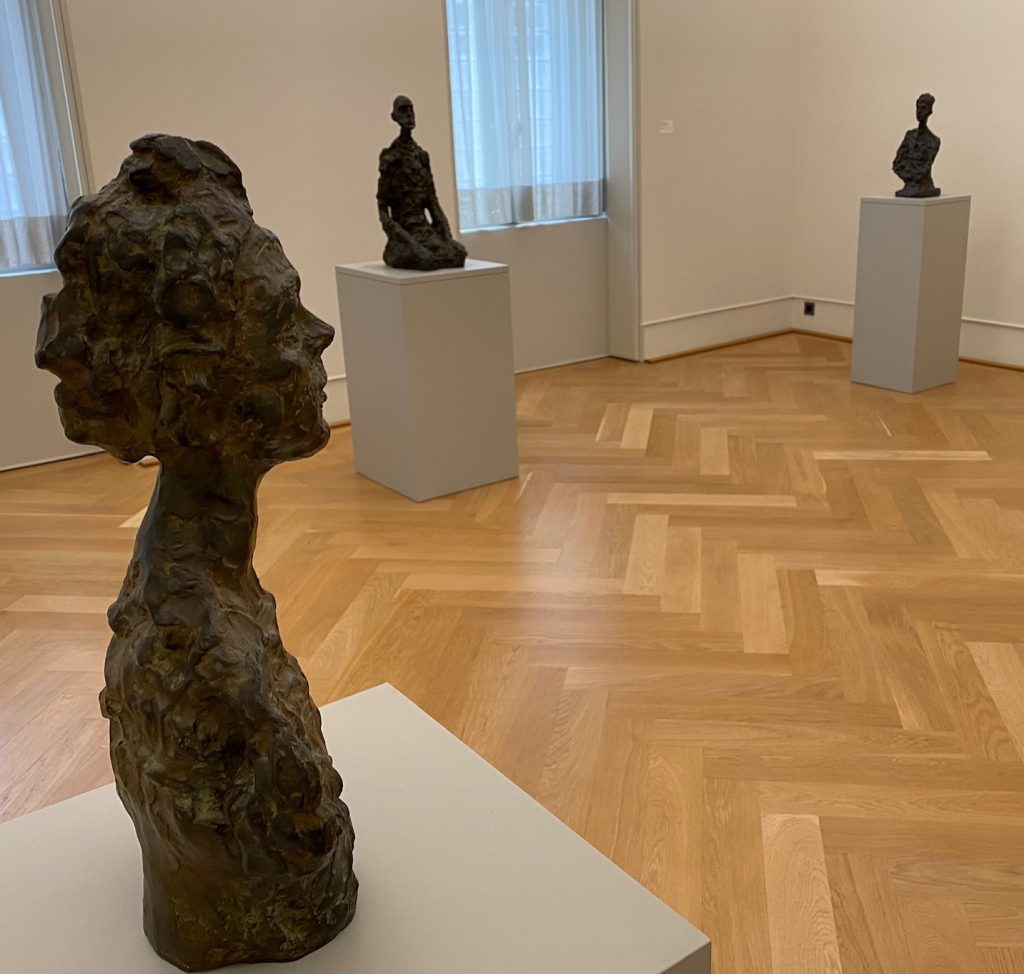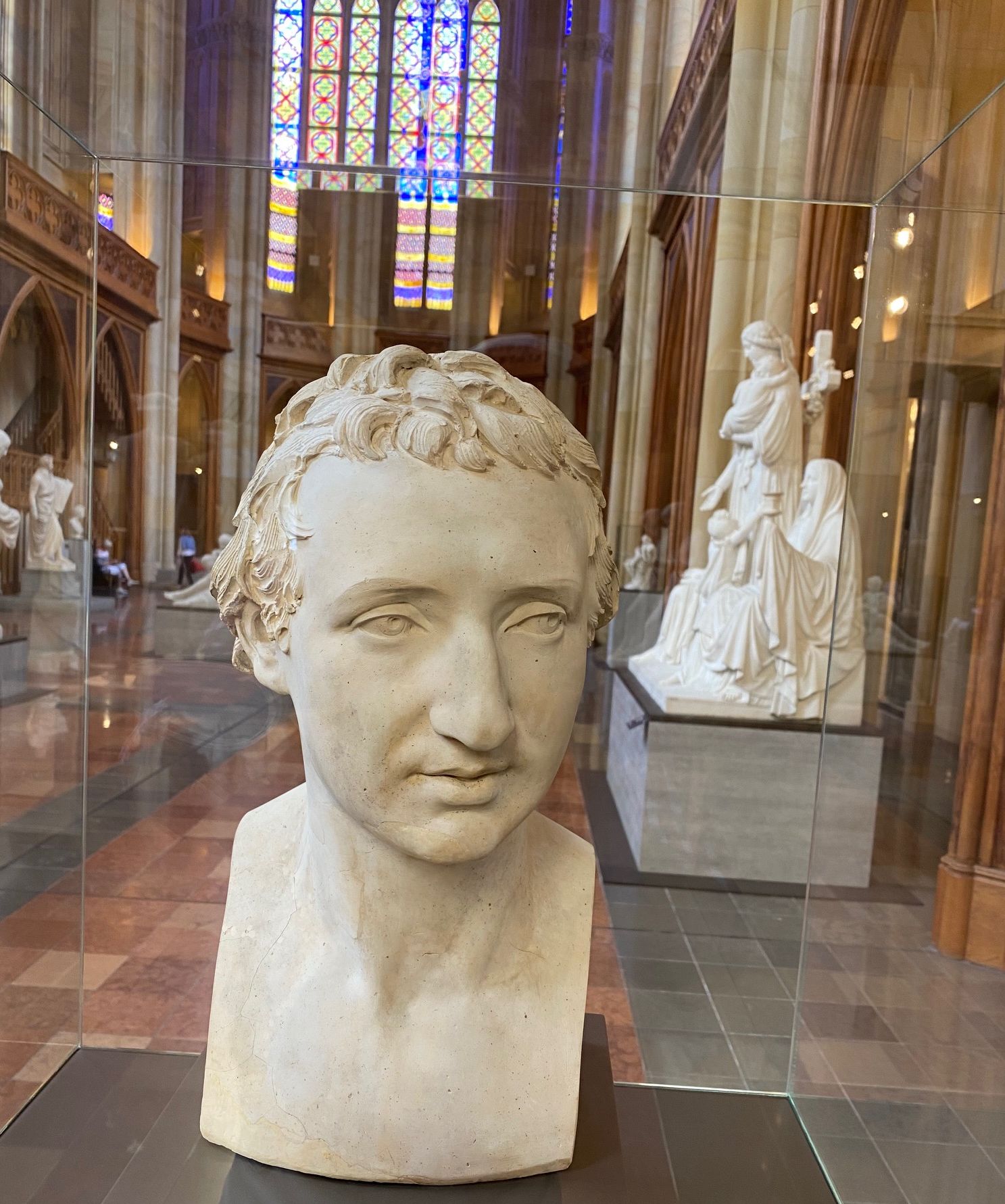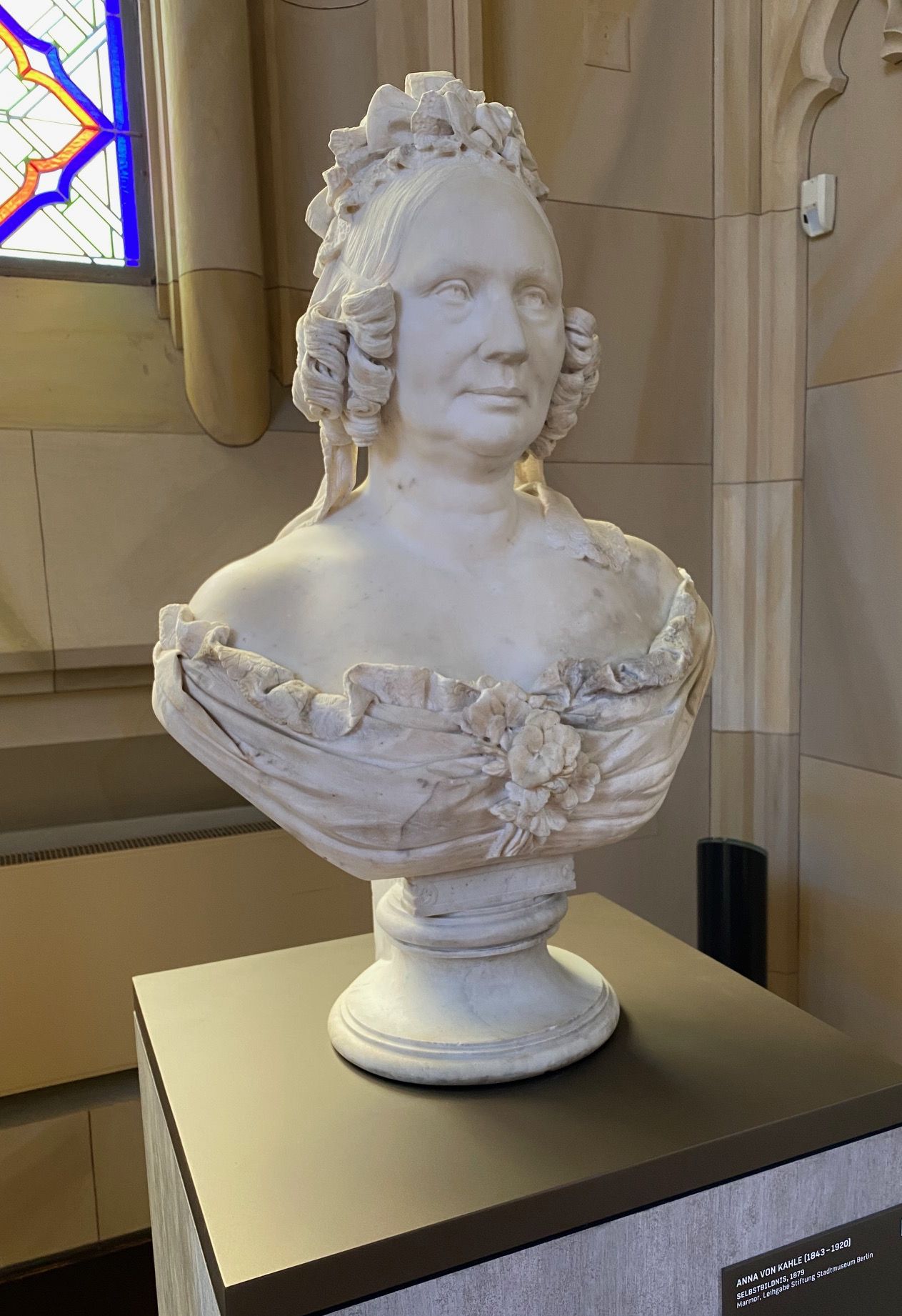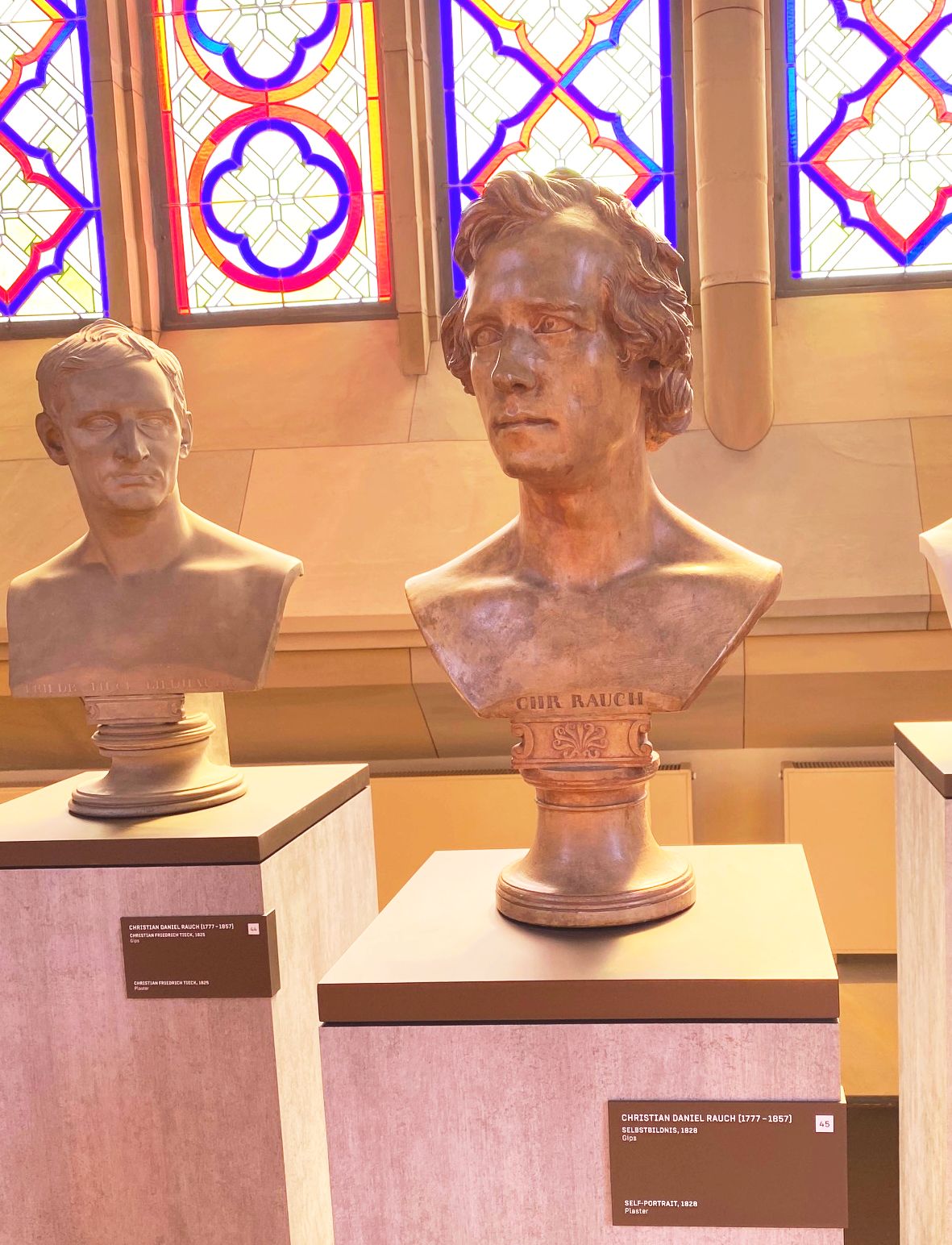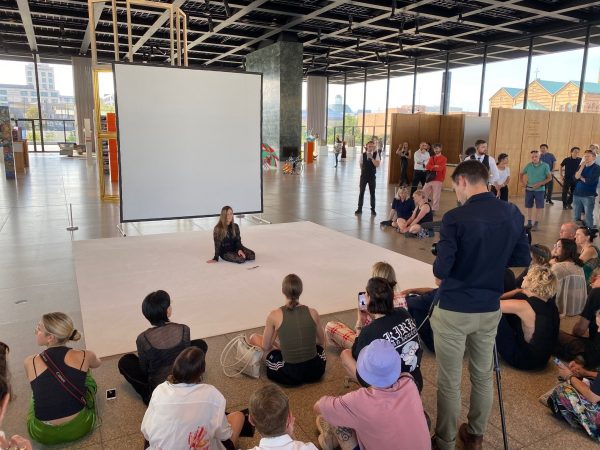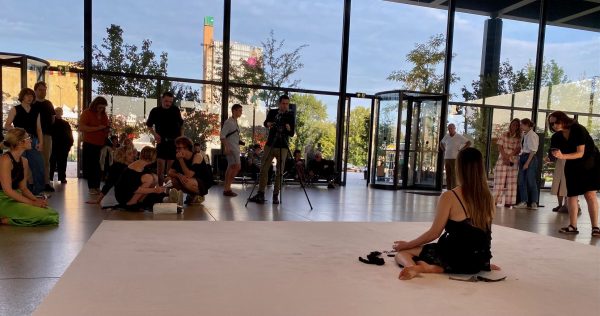Jon Fosse has been awarded the Nobel prize for literature in 2023. Alfred Nobel donated the original funds out of his entrepreneurial empire build on the patents for dynamite. The explosives have ample use in peaceful times, but especially at times of war with noisy and destructive explosions. Experiments, with the tragic outcome killed together with 4 other victims his own brother. It did not stop him to pursue his entrepreneurial endeavour. In 2023 the Russian aggression continues to use explosives to kill innocent civilian victims. The sound of bombing continues to traumatise or destroy existences. The Nobel Prize for literature awarded to Jon Fosse does not bring those killed to live, but it is yet another reminder that silence or the absence of Alfred Nobel’s noise is invaluable. Norwegian Fjords and the water all around surely inspired Jon Fosse.
The scope of his writing ranging from theatre, prose to poetry and children’s books is comprehensive and impressive. This is probably all well known to many theatre-goers and readers beyond their mother tongue. For Germany there is an additional feature to the literary work of Fosse. Hinrich Schmidt-Henkel is the almost exclusive translator of the German language editions. This is already an impressive amount of work and long-term commitment to and from a translator as well as the publishing house Rowohlt. The Wikipedia entry for Hinrich Schmidt-Henkel shows the numerous works as translator of Jon Fosse as early as 2001 and still more to come. Additionally, Hinrich Schmidt-Henkel translates other classic authors from Norwegian into German in collaboration with the publishing house Guggolz located in Berlin-Schöneberg.
Besides the passion for translation Hinrich Schmidt-Henkel is active to defend the rights and salaries of translators. The threat to professional translation work by AI-programmes is imminent and just like authors and actors (not only in the USA) face continuing challenges for proper remuneration of their work. Being the German “voice” of Jon Fosse, it depends very much on specific contractual arrangements, whether a translator will also benefit not only from the popularity, but also in financial terms from the “windfall” profits reaped by authors and publishers. This constitutes probably a rather explosive issue, but worthy to be addressed eventually by the Nobel Committee. It is a “winner takes all” system just like with explosives, at least until next year’s awards. (Image Hinrich Schmidt-Henkel presenting Biermann in Staatsbibliothek Berlin 2023-9). 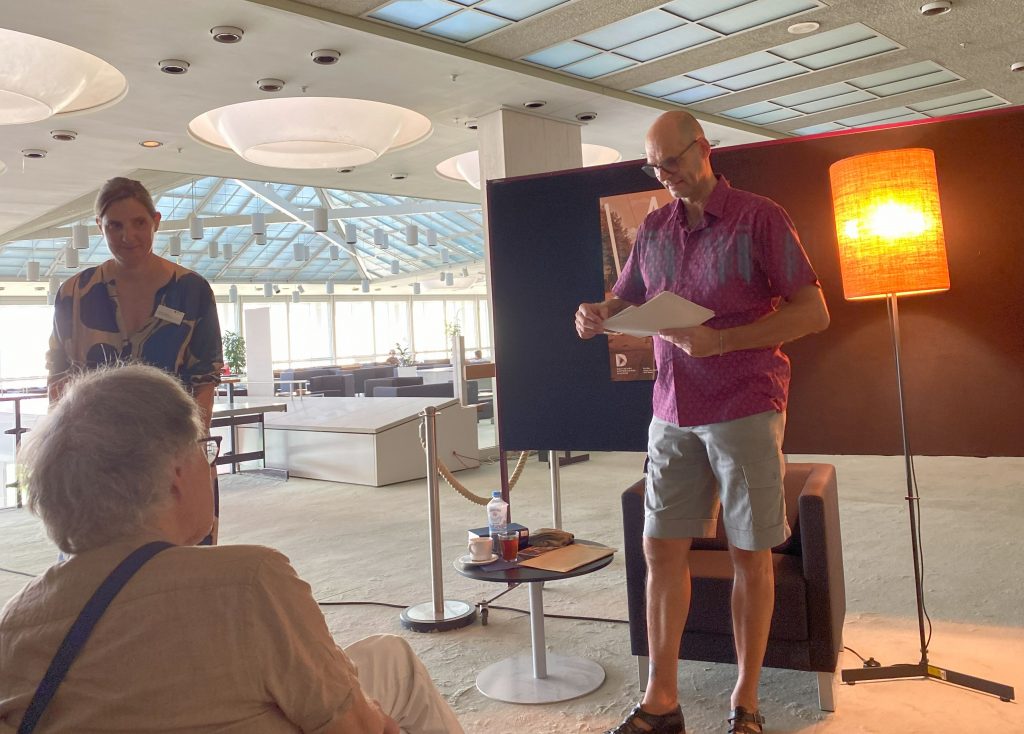
Komposition
Es ist eher selten geworden, dass sich große Häuser der Musik den Komponisten der Moderne widmen. Es sind wohl auch nicht viele Publikumsrenner dabei. Das liegt sicherlich zu großen Teilen an der mangelnden Bekanntheit der Werke moderner Komponierenden und ihrer Werke. Karlheinz Stockhausen bildet da keine Ausnahme mehr. Das Konzerthaus Berlin hat in seiner Reihe 2 x hören einen Abend einem Werk von Stockhausen gewidmet. „In Freundschaft“. Wichtig ist zu diesem Werk eine Einführung in die Kompositionstheorie von Stockhausen. Die serielle Komposition baut auf einer einfachen Struktur von Notengruppen auf. Christian Jost erläutert zusammen mit den Vortragenden in einzigartiger musikpädagogischer Weise die Komposition. Eine Information über Wikipedia vorab erleichtert den Zugang und lässt uns die Komposition vereinfacht nachvollziehen. Auf Youtube gibt es dann verschiedene Versionen für jeweils andere Soloinstrumente zu finden. Beispiel Klarinette hier. Die Basiselemente bestehen aus 1,3,2,5,8 Noten, also ein Gesamtthema von 19 Noten aus 5 seriellen Bestandteilen. Die Variationsmöglichkeiten bilden bereits eine vielfältige Auswahl plus den anderen Varianten wie Spiegelungen oder Transkriptionen auf höhere oder tiefere Tonlagen. Komponieren wird spielerisch und bleibt ein Klangerlebnis. Reinhören online lohnt sich zum Verständnis moderner Ansätze der Kompositionstechnik.

Schachnovellen
Eigentlich gibt es nur „die“ Schachnovelle von Stefan Zweig aus dem Jahr 1942. Heutzutage schon zu haben für 3 € (Reclam) als Reisebegleiter. Die Ausgabe ist gerade so groß wie ein Mobiltelefon. Darauf habe ich natürlich noch ein Schachprogramm mit unzähligen Rätseln und Partien, nur für den Fall eines Rückfalls. „Damenopfer“ sind im Schach eine elegante Art, die mächtigste eigene Spielfigur zu opfern, um einen strategischen Vorteil oder gar Schachmatt zu erreichen. Kurz gesagt, der König opfert seine Dame, damit er den anderen König überwältigen kann. Shakespeares Dramen klingen dabei an.
Aktuelle Literatur „Damenopfer von Steffen Kopetzky“ setzt ebenfalls auf diese Analogie. Aber zurück zu der Schachnovelle. Meine Lesart der Novelle, bei der aus dem kleinen Bauernjunge, der spätere Schachweltmeister geworden ist, bezieht sich auf die Menschheits- und Realitätsflucht des Schachspielens. Eintauchen in die Welt der Figuren und verbundener Fantasien bietet sich an. Neben Königen und Königinnen, stehen Türme von alten Ritterburgen, Pferde samt Reitenden als Teil von Reitturnieren, Läufer mit Kurz-, Langstrecken oder Marathondistanzen, sowie die Menge an Bauern, die für Nahrung sorgen, Deckung bieten und die Logistik bewältigen. Essentielle Arbeitende eben. Schon bei Verlust eines einzigen Bauers ist die Partie bei Fortgeschrittenen meistens schon verloren.
Das Eintauchen in die Parallelwelt des Schachspielens kann zu schizophrenen Verhaltensweisen führen. Ausblenden aller realen Vorgänge und Leben in mehreren möglichen gleichzeitig stattfindenden Parallelwelten als Varianten von Schachpartien verlangt mentale Stärke. Ab einem gewissen Niveau des Eintauchens in die Schachwelten, gleichsam von Schachnovellen, wird die Rückkehr in die real stattfindenden Vorgänge ebenfalls schwieriger. Spielsucht kann die Folge sein. „Gamer“ mit ihren virtuellen Welten und Abenteuern wissen sicherlich nur allzu gut, welche Gefahren dort lauern.
Stefan Zweig hat seine Schachpartie im realen Leben gegen den Nationalsozialismus verloren. Die gewählte Selbsttötung seinerseits war ein Königsopfer, das ein spielerisches Damenopfer in den Schatten stellt. Zu Recht steht die Schachnovelle oft auf dem Schulcurriculum, nicht nur da, wo Schachspielen Unterrichtsfach ist. 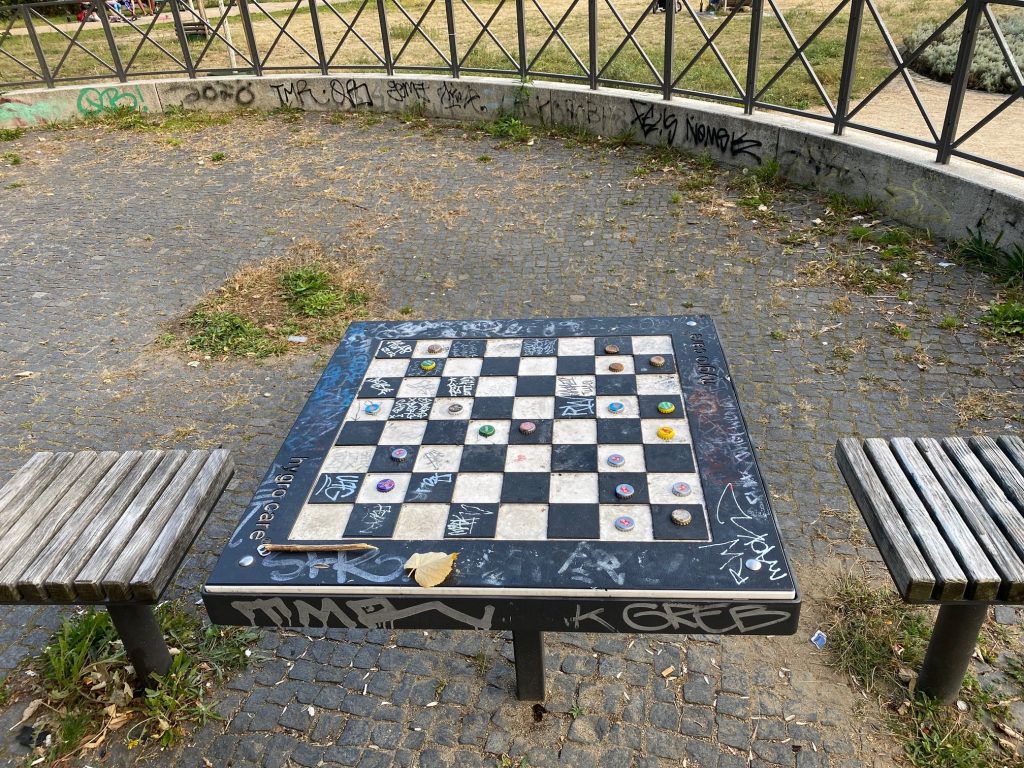
Auenlandschaft
Die Auen und die Wälder in der unmittelbaren Nachbarschaft hatten eine hohe Bedeutung für die Biodiversität. Mit ihren fruchtbaren Böden waren sie leider sehr begehrt für die Landwirtschaft und wegen Wassernähe auch für Wohnungsbau. Die Auen haben eine wichtige Funktion als Aufnahmefläche für Hochwasserschübe an allen Binnengewässern. Das haben wir in Deutschland an der Ahr schmerzlich wieder erleben müssen. Nachhaltiges Wirtschaften mit den Auen statt gegen die Auen ist möglich. Selbst der langsame Rückbau von befestigten Flussufern ist möglich, wenn Ausgleichsflächen für Überflutungen erschließbar sind. Das braucht eine langfristige Planung. Diese fängt meistens auf den umliegenden Bergen und Hügeln an, die nicht mehr nahezu ungebremst große Wassermengen rasch in die Flüsse ableiten. Auffangbecken, die höher gelegen sind, Versickerung, die nachhaltig bewässert, sind verbundene Planungsvorhaben, die zusammengenommen eine wirksame Antwort auf den Klimawandel bilden.
Auen haben feuchte- und wärmeregulierende Funktionen, die den umliegenden Dörfern und Städten zu Gute kommen. Elektrisch betriebene Schiffsmotoren drehen leicht mit höheren Drehzahlen und Vermeiden dadurch zusätzlich die hohen Heckwellen, die sonst oft bei langsam drehenden großen Schiffsschrauben zu beobachten sind. Als Naherholungsgebiete sind die Auenlandschaften sehr beliebt und nicht erst seit den Malenden der Romantik. Die größere Biodiversität sollte eine Antriebsfeder sein, diese Naturschönheiten zu bewahren und, wo möglich, wieder herzustellen. Leipzig hat das erfolgreich durchgeführt (Link PDF). In Frankreich tragen die Rückhaltebecken der Marne wesentlich zur Verbesserung der Wasserqualität der Seine bei damit mittelfristig darin sogar wieder gebadet werden könnte. 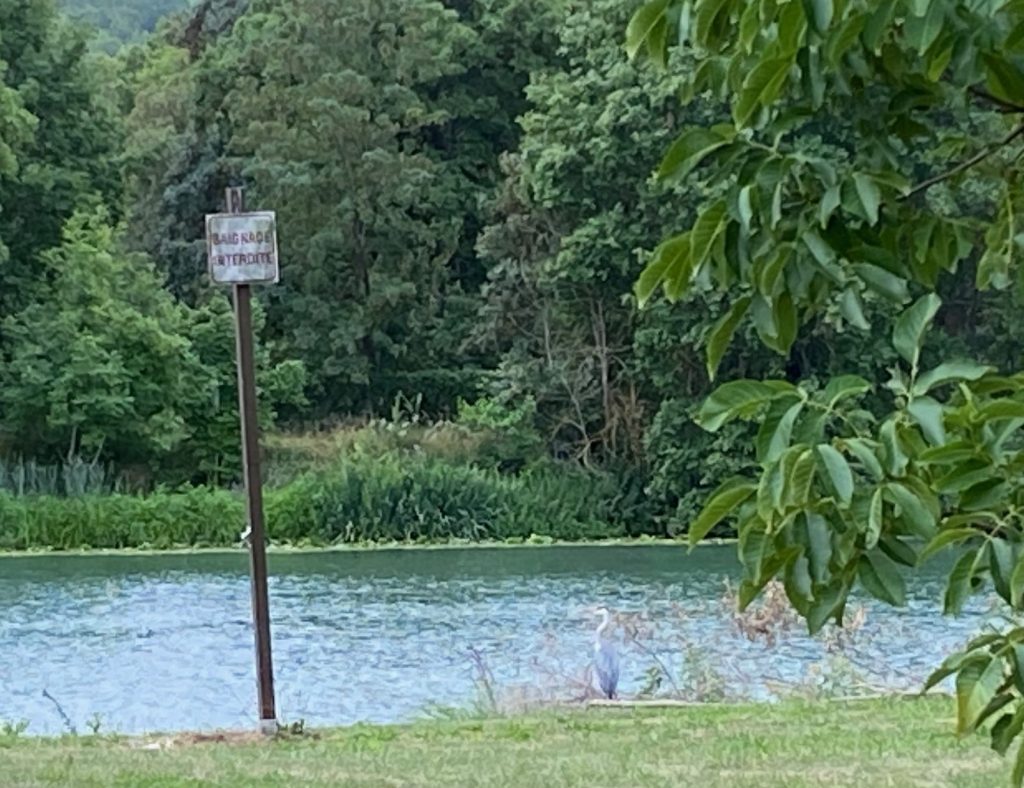
Marathon Berlin2023
Berlin celebrates its 49th Marathon in September 2023. The first Berlin Marathon in 1974 had less than 300 participants. To separate this from Olympic games, these runs were coined “Volks-marathon” at the time. 5 events had already taken place in New York when these annual events started to catch on in Berlin. In 2023 there are close to 50.000 participants mostly drawn from a lottery of about 500.000 entries. So, you can call yourself one of the lucky few, if you manage to get a place. The event is a drain, but it creates a fantastic hype not only for the runners. The many cheers and bands along the running track transform the inner city into a huge party zone. The Berlin marathon is known around the world for its fast track. In 2023 Berlin is proud to be the city where both the women and men’s world record are held currently at the same time. This is quite an achievement.
Personally, I enjoy more the courage, stamina and will power all the participants gear up to. Months, if not years of preparation find their climax in getting to the starting line in the “Tiergarten”, just where you had (have) the “Love Parades” some weeks before. The finishing line is 300 meters away, once you have passed the “Bandenburger Tor”. From a public health perspective, we applaud the encouragement such events give to all those that have an active life style and to some to get started on such a trajectory. The media coverage is enormous and with all sponsorships, equipment, hotels, meals and travelling involved such events have become big business, too. No such event and going to health limits is without risk. This is, of course, also the case in Berlin. The emotions run high for almost all, except for a few, who go too far beyond their limits.
The medical assessments of exhaustive endurance sports are an ongoing research issue. A recent literature review reveals that there are quite substantial numbers of previous smokers or persons with previously unhealthy life styles participating in popular marathons. Running, probably, has been part of overcoming bad habits of the past. It is therefore, not surprising to find that some of the participants are at a risk of wanting to run too much or too fast for their current state of health. The hypnotising effect of music and stimulation from being part of a huge crowd, contribute to the effect to go beyond limits. Cardiovascular events or brain lesions are, therefore, part of the ex-post risks of participants who have had specific medical check-ups. Know your limits, train them wisely, but respect that limits exist. This seems to be a reasonable summary based on sports medical research. Berlin 42km finishing line2023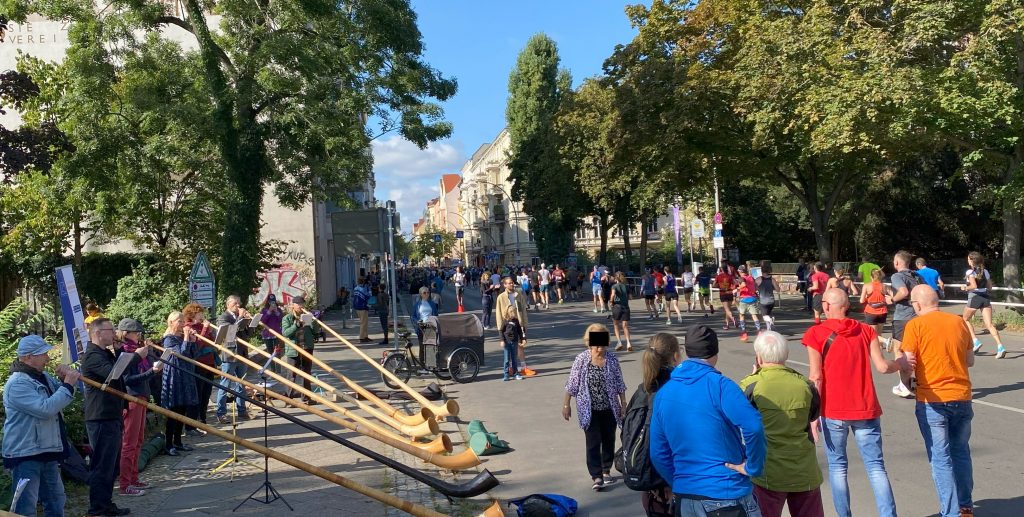
Luftschloss
Im K21 der Kunstsammlung Nordrhein-Westfalen ist ein Luftschloss eingebaut worden. Es ist das einzige mir bekannte Luftschloss, das für alle Besuchenden begehbar und fühlbar ist. In wahrhaft luftiger Höhe von 25+ Metern über der Eingangshalle der Kunsthalle K21 und zentral unter der gläsernen Dachkuppel platziert, lässt sich mal so richtig abhängen. Nahezu schwebend kann die weiträumige Installation von Tomás Saraceno erklommen werden. Die Schritte und wippenden Bewegungen der anderen BesucherInnen lassen sich unvermittelt ebenfalls erspüren. Du bist nicht allein, im originären Sinne des Wortes. Die buchstäbliche Vernetzung mit allen anderen Personen werden durch Schwingungen des Netzes zu anderen Kletternden oder Chillenden übertragen. Eine unmittelbar erlebbare Erfahrung der Verbundenheit mit unbekannten, anderen Menschen stellt sich ein. Die Verbundenheit innerhalb einer Gesellschaft wird eindringlich verdeutlicht. Die Angst, durch die Höhe verursacht, weicht rasch der freudigen Erfahrung der Schwebung und der kindlichen Erfahrung der Suspension. Nahezu freischwebend in der Luft, im Orbit erlebt jede/r sein eigenes Luftschloss inmitten von transparenten Kugeln, die wie Planeten wirken. Gleichsam real, aber dennoch imaginär durchwandern wir die Installation immer im Bewusstsein, dass andere um uns sind, die unsere Schritte, Möglichkeiten und Haltungen mit beeinflussen. Vom Luftschloss träumen oder im Luftschloss träumen, beides ist dort machbar.
CO2 freundlich lässt sich die Erfahrung in der APP Aerocene fortsetzen. Der für unser Wetter so bedeutsame Jetstream wird zur imaginären Flugerfahrung genutzt und mit recht aktuellen Daten gespeist. Die Verbindung zu „Earth and Space Sciences“ ermöglicht die Einbettung der sozialen Erfahrung in einen noch weiteren Kontext.
Die eigenen 4 Wände sind die Grenze. Das galt schon früher nicht. Weit darüber hinaus lassen sich neue Möglichkeiten erschließen, die nicht umweltbelastend sind. Selbst die Reichstagskuppel in Berlin sehe ich plötzlich mit ganz anderen Augen. Mehr als Möglichkeitsraum, statt der traurigen Vergangenheit und der zerstrittenen Gegenwart. Was wäre die Kunst, wenn sie nicht zum Träumen anregen würde. 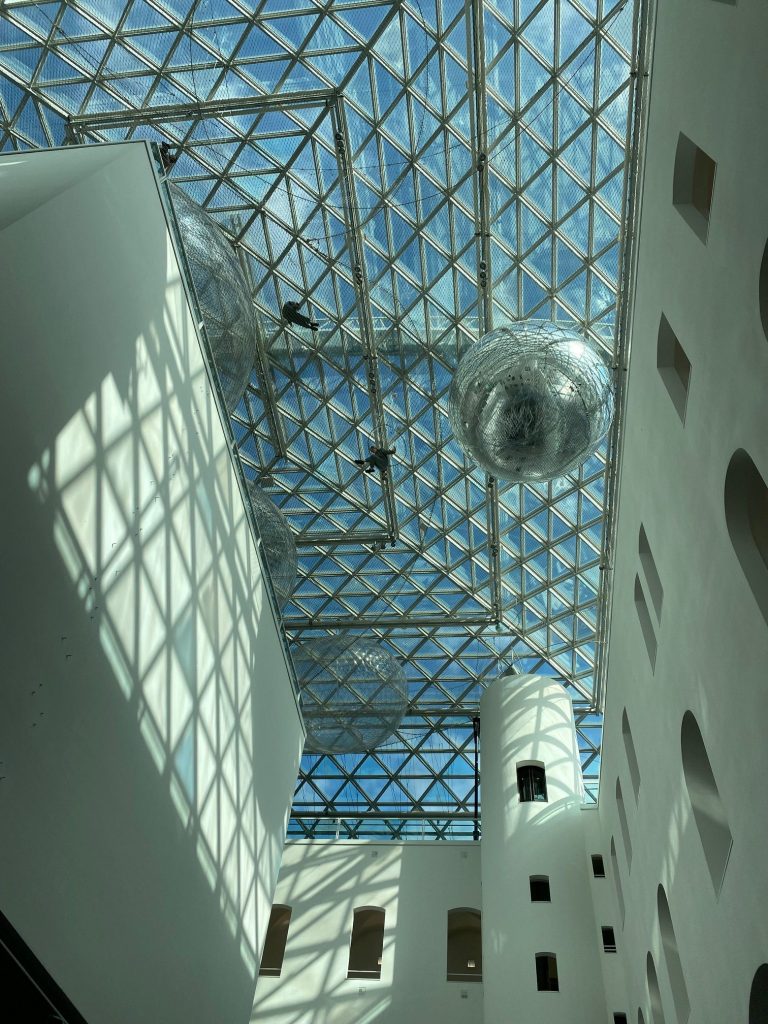
Kunstsammlung
Viele Kunstsammlungen in der westlich dominierten Kunstwelt haben nicht nur ein Übermaß an Beständen von Männern gegenüber von Frauen, sondern ein noch größeres Gefälle zwischen westlichen Kunstschaffenden und Kunstschaffende globaleren Ursprungs. Die Kunstsammlung Nordrhein-Westfalen versucht in 2023, diesem Bias zu begegnen. Die Preisträgein des K21 Global Art Award an die Südafrikanerin Senzeni Mthwakazi Marasela (Image unten aus der Ausstellung K21) steht für starke Frauen, die mittels der Kunst, Geschichte und Geschichten erzählen und damit dokumentieren. Wir brauchen viele dieser Stimmen.
Der Kunstkalender 2023 bringt zudem über den Jahreswechsel hinaus „Isaac Julien“ in die Kunsthallen in Düsseldorf mit seinen beeindruckenden Filminstallationen. Immer unter dem Thema der Gleichberechtigung sind seine Werke eine unablässige Hinterfragung der von uns, der Gesellschaft, produzierten und sich ständig reproduzierenden feinen Unterschiede. „What freedom is for me”, so der Untertitel der Ausstellung, erlaubt den Perspektivenwechsel und, sich die Bedeutung des Freiheitsstrebens der „People of Colour“ zu vergegenwärtigen. Jenseits der Freiheit, als Abwesenheit von Unterdrückung, Angst und Ausbeutung ist Freiheit etwas zu tun, zu denken, sich auszudrücken die Nagelprobe auch der Gleichberechtigung. Unsere großen Ausstellungshäuser und Sammlungen sind sich ihrer Verantwortung bewusst geworden. Manche Museen erwachen gerade erst aus den Schrecken, die sie in ihren Sammlungen vorfinden. Im Interesse der Freiheit und Gleichberechtigung erwächst den öffentlichen Institutionen dabei eine Verantwortung, die immer schon da war, aber erst in den letzten Jahren intensiver angegangen wird.
Jede Sammlung ist selektiv, sonst wäre es wohl keine Sammlung. Den Waffen- und Trophäensammlungen der letzten Jahrhunderte müssen wir heutzutage Sammlungen hinzufügen, die neue Möglichkeitsräume erschließen und Empowerment befördern. Los, sammeln wir. 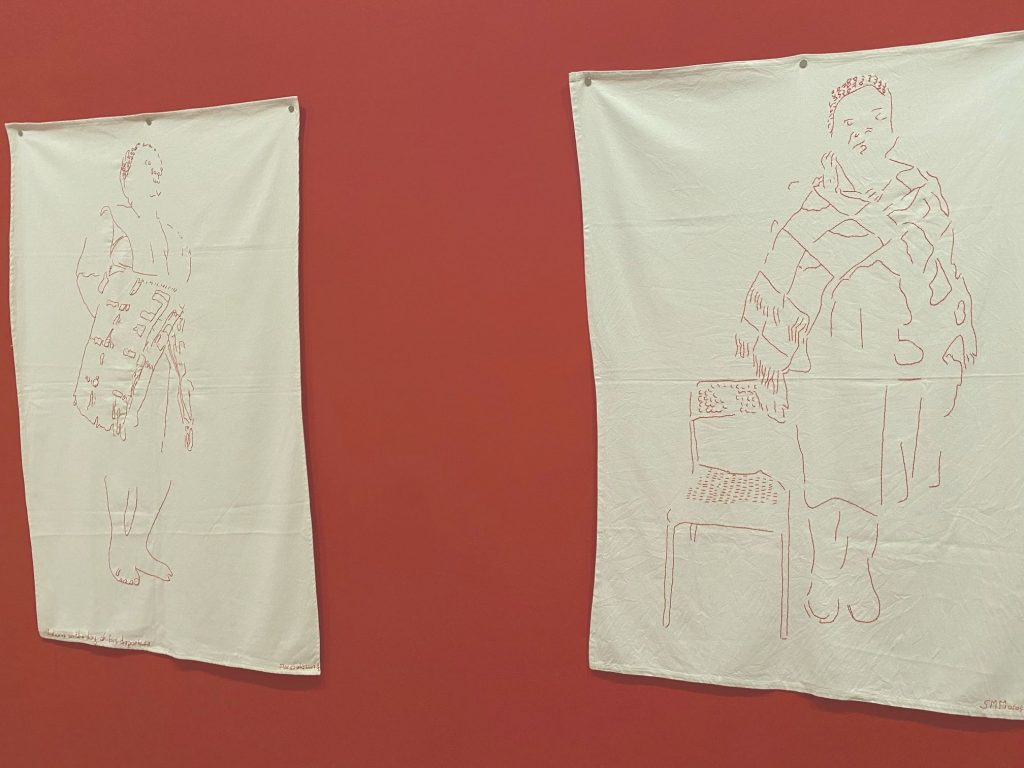 Senzeni Mthwakazi Marasela 2023 K21clipvideo
Senzeni Mthwakazi Marasela 2023 K21clipvideo
Selfie 3D
Wir meinen gerne die heutigen Gewohnheiten, wie die ständigen Selbstbildnisse seien eine Erscheinung des 21. Jahrhunderts. Weit gefehlt. Wer es sich früher schon leisten konnte, hat sich malen lassen. Photographen haben später diesen Markt übernommen. Aber eben auch Kunstschaffende haben seit langer Zeit ihr Selbstbildnis gezeichnet, gemalt und in Stein oder Gips geformt. Selfies sind daher eher die Demokratisierung der Möglichkeiten, sich selbst zu inszenieren. Eben sich so zu portraitieren, wie sie oder er sich selbst sieht, sehen möchte oder gesehen werden möchte. Es ist daher weniger ein narzisstischer Charakterzug die Antriebsfeder, sondern für die meisten Menschen steht ein Teilen, eine Form der Interaktion mit anderen im Vordergrund. Die portraitierte Person ist da, auch wenn sie gerade nicht da ist.
Diese Intention haben Herrschende jahrtausendelang genutzt und sich Mausoleen und Pyramiden errichten lassen. Gut, dass diese Praxis weit in den Hintergrund getreten ist. Heute regeln wir bereits unseren digitalen Nachlass in Ergänzung zu unserer analogen Hinterlassenschaft. Für viele werden dabei, ganze Sammlungen von vielfältigen Selbstbildnissen zu verwalten sein. Die 3D-Ausdrucke unserer Gesichtscanns samt mehr oder weniger noch vorhandener Haarpracht kommen dann in eine eigens vorbereitete Vitrine. Selbstverständlich gehören die MRTs und sonstige Scanns von ZahnärztInnen auch in die Sammlung. 3D ist schon ein guter Anfang auf der Interaktionsreise mittels Selbstbildnis. 4D Realisationen, wie Yoko Ono mit ihrem Cut Piece 1967 kamen dann später. (Photos from Friedrichwerderschen Museumskirche, Berlin 2023 Austellung Ideal und Form, li: Schadow Selbstbildnis, mi: von Kahle, re: Rauch).
Berlin Grün
Zur Berlin Art Week BAW 2023 wurden der Neuen Nationalgalerie ein paar Blumen und Baumkästen spendiert. Alles nur vorübergehend. So erblühte die Rose von Isa Genzken schon vorher und sicherlich noch etwas länger vor der Neuen Nationalgalerie. Steht der Galerie gar nicht schlecht. Vielleicht etwas sehr figürlich und wenig auf die Schätze der Moderne hinweisend. Das ist schon eher post-modern. Rückbesinnen auf die Werte der Natur, dass Stahl und Glas eben nicht umsonst zu haben sind, sondern erhebliche Umweltkosten mitsichbringen. Das regt zum Nachdenken an. Solarzellen, quasi unsichtbar auf dem großzügigen Flachdach der Galerie und für die geplante Scheune nebenan? Kunsträume stehen ebenfalls in der Verantwortung für die Überlebensbedingungen unseres Planeten. Denkmalschutz kann weitgehend eine Bremse sein, aber die energetische Verantwortlichkeit der immer gut gekühlten und beheizten Räume sollten auch wegweisend in dieser Richtung sein. Da gibt es noch viele Potenziale, die es auszuschöpfen gilt. Damit kann dann auch mehr Kunst gezeigt werden, da die laufenden Kosten gesenkt werden können für mehr als eine Wahlperiode oder Amtsperiode einer Hausleitung. Also Kunst kann einen schon auf unangenehme Gedanken bringen, die die Kunstschaffenden und Kuratierenden selbst betreffen. Isa Genzken und die BAW setzen Zeichen, die vielleicht so gar nicht unbedingt geplant waren. Nice. 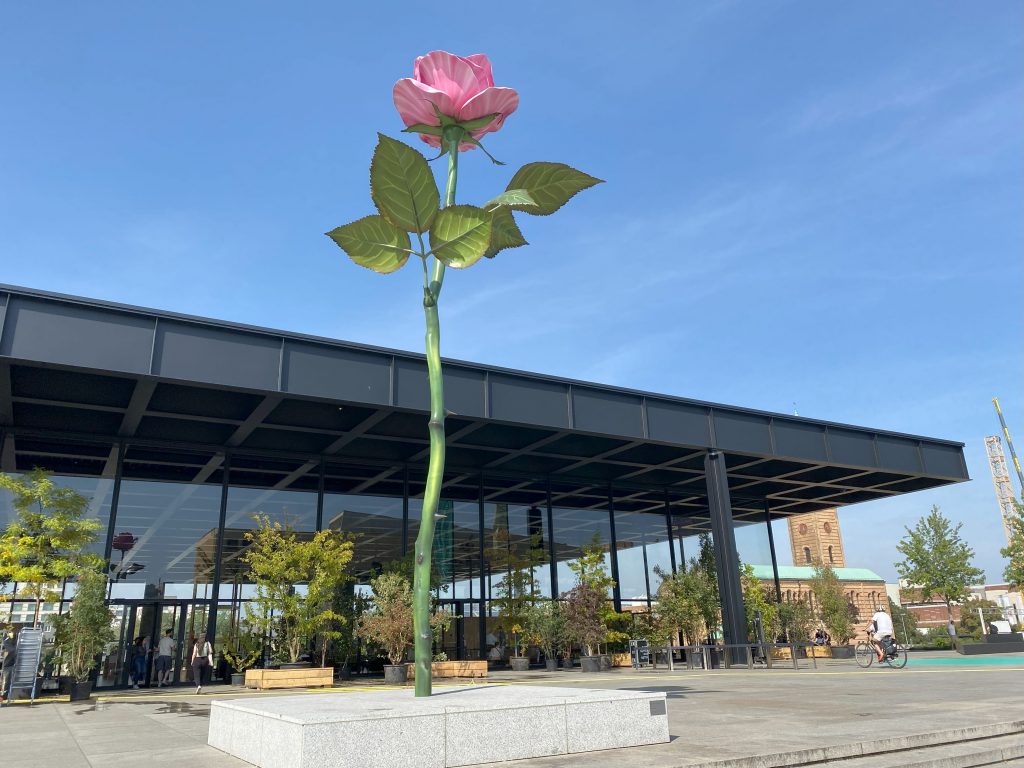
Heritage Day
A heritage is something you might carry with you, no matter whether you like it or not. In architecture this is most vivid and visible. On the 2023 heritage day i Brussels many monuments and institutions open their prestigious buildings to the public and show off their “silver” or gold plated walls and ceilings. Just next to Royal Palace is the home of princesses and princes now inhabited by the Royal Academy. Even the stables have been packed with books now, all in all 19 km of shelves packed with papers of all sorts. Great that many academics and academies have shifted to electronic publishing so that the CO2 footprint of science and art can finally be reduced as well.
Of course, we adore the old postcards to learn about historical trajectories of architecture and specific buildings. The collection is a great collective memory.
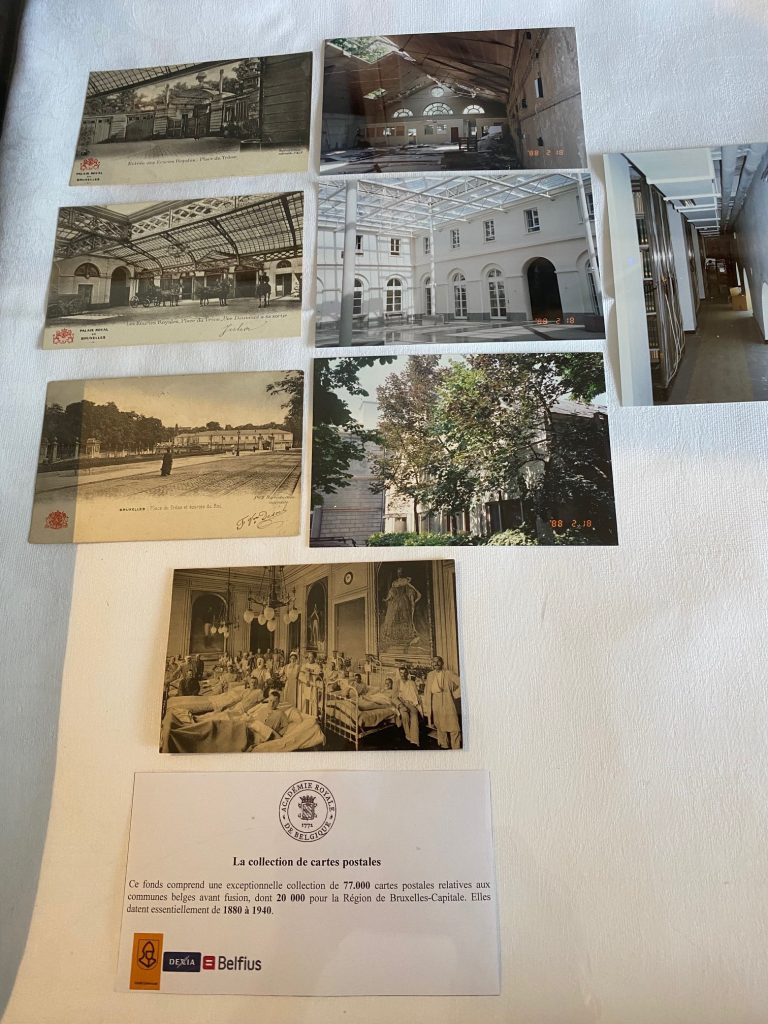
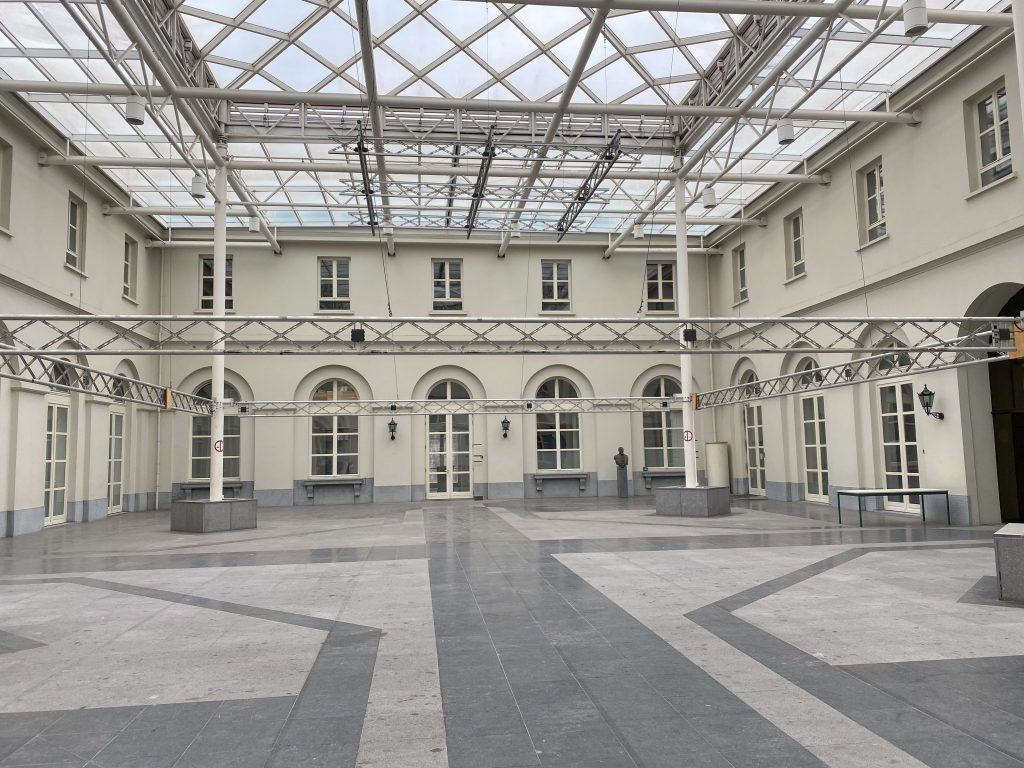
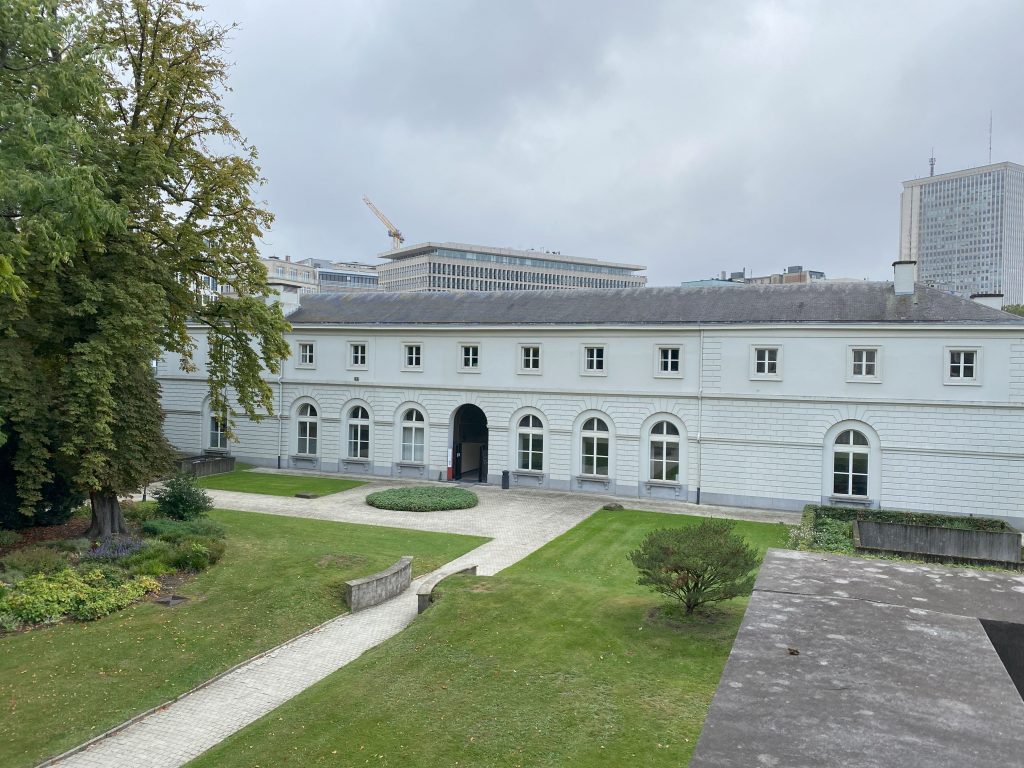
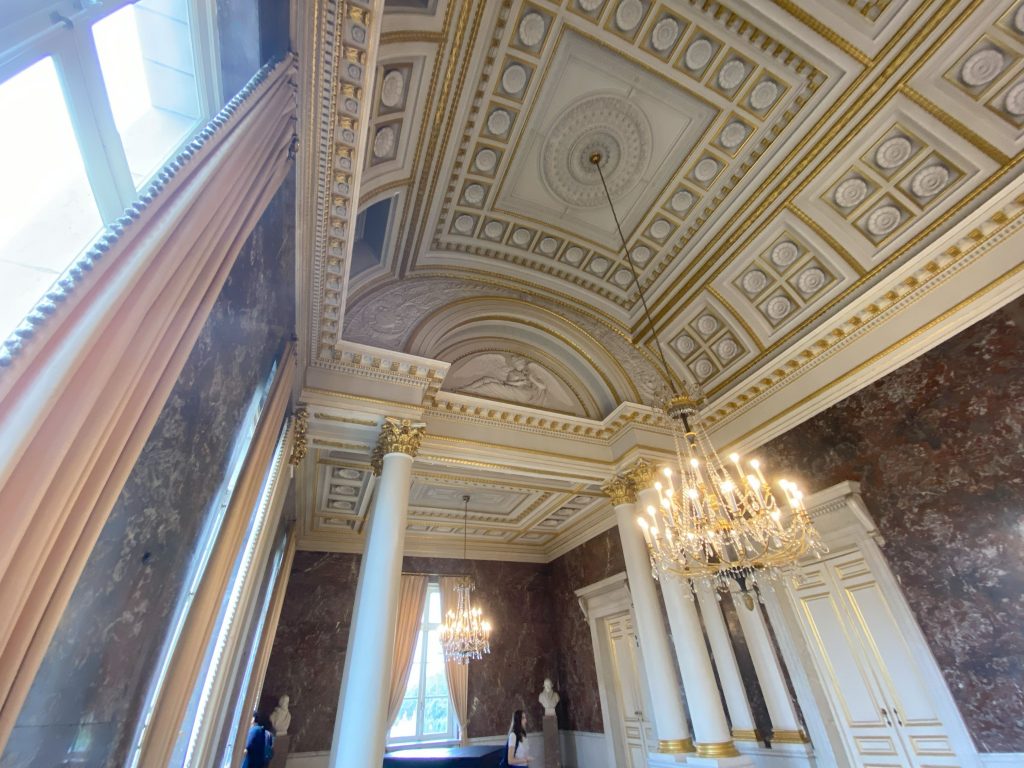
Participative Art
Beyond participation in the performance based on Yoko Ono’s Cut piece 1964, you had the possibility to imagine yourself as a sculptor by touching a sculpture of art 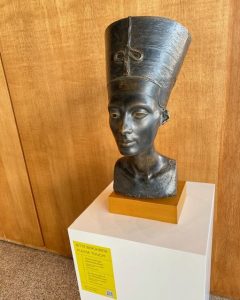 attached to the Genzken exposition, nothing less than the head and bust of Nefertete, also a piece transformed by Genzken and exposed, untouchable, in the exposition. You can hardly get more involved and incited to participate with hands-on experience, so to speak.
attached to the Genzken exposition, nothing less than the head and bust of Nefertete, also a piece transformed by Genzken and exposed, untouchable, in the exposition. You can hardly get more involved and incited to participate with hands-on experience, so to speak.
Additionally, there is the perspective from the performing artist in “Yoko Ono’s Cut Piece” to confront the spectators with a silent, stoic expression hardly moving during the more than 90 minutes performance. Imagine, what kind of vulnerability you are risking. Artists give a lot from themselves to the public. Imagination is even going beyond the act performed. Mastering your own fear of mutilation or being exposed to views, touching and multiple other forms of sensation.
This surely is an exercise of mental strength. Spectators also interact with other participants as, for example, spontaneously another spectator too the scissors to cut his own shirt in front of the performing artist and covered the shoulder of the performer. The personal interaction assures a more intense experience of art.
After all, this is a well-known principle to enhance learning experiences as well. Imagine all the people, each taking just a tiny little piece and remember their experience that they, as well, can be actively contributing to art. Reviving this participatory experience is leading beyond imagining only your participation. Democracy is built on this stimulating experience as well. It is ever so necessary to foster participation and to overcome indifference or abstention. Learning by doing, or experiencing through touching, offer many additional insights.
(Images and videos taken on 2023-9-12, Berlin)
Revival
Almost 50 years after the first performance of Yoko Ono “cut piece” (1964), as a silent performance, it was performed again at the beginning of the Berlin Art Week (BAW2023). The “Neue Nationalgalerie” opened the art week somehow, in honour of her. The performance consists in the interaction with the audience inviting persons to approach her in front of the other spectators to cut a piece of her dress. They are allowed to keep the cutting and walk away with a little piece of her dress. In the 60s this was quite a big deal. Nowadays, after the fall of the wall and the wrap-up of the Reichstag by the Christo couple, we have become used to such kinds of take-home pieces and sharing in art work or historic moments. Hence, this was the chance for Berliners to add another valuable piece to their collection consisting of a piece of painted concrete from the Berlin wall as of 1989, Christo-foil in 1995 from the Reichstag and now the tissue from the live performance in honor of Yoko Ono.
The participation in the art performance invites several interesting approaches.
First the artist exposes herself in an extremely vulnerable fashion. The scissors in front of her make for a weapon in the hands of an aggressive person. Therefore, the number of security guards was beyond the scope of a normal protection of art hanging on the wall or sculptures exposed. In the background of the performance is the exposition of work from Isa Genzken which has been much less of a security risk. Her super-size rose in front of the gallery is accessible night and day. Some of the images taken have a somewhat blurred, more distant view on some pieces of Genzken’s work as well. The entry hall of the Neue Nationalgalerie allows a fabulous transparency of art and invites persons passing-by to attend spontaneously the performance as well.
(Images and videos taken on 2023-9-12, Berlin). Video Clip here.
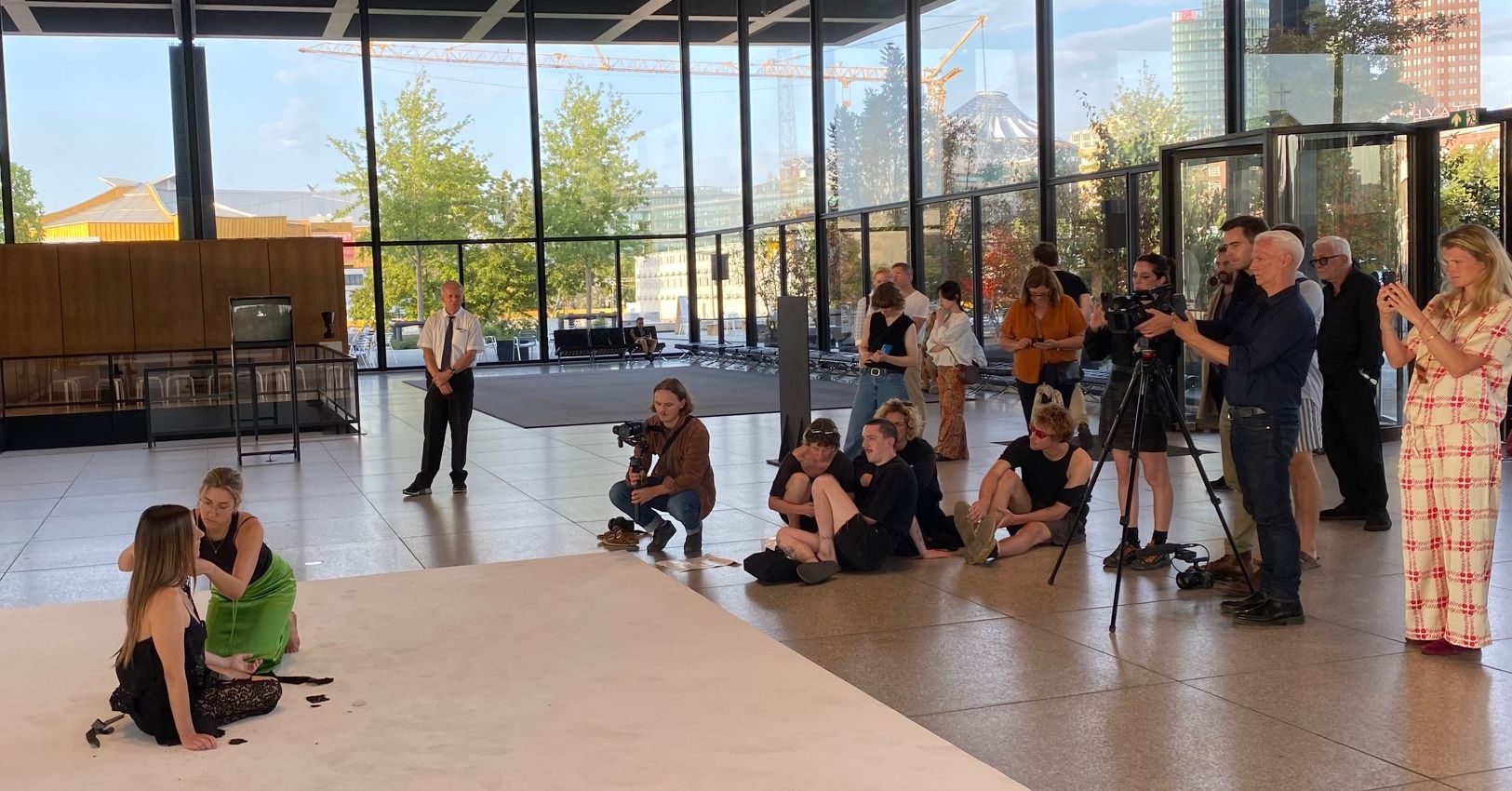
Li-Be
Jede/r hat so seine Assoziationen mit Li_be. Für eine kleine Gruppe von Literaturbegeisterten steht Li-Be seit langem für das Literaturhaus Berlin. Das war nun ebenfalls, anlässlich des Tag des Offenen Denkmals, im September 2023, als solches zu besichtigen. Zentral am Ku’damm plaziert, in der benachbarten Fasanenstraße, liegt diese geschichtsträchtige Villa in mitten eines kleinen Gartens. Trotz wechselvoller Geschichte konnte die Villa als Ganzes erhalten werden, nachdem der Denkmalschutz Veränderungen untersagt hatte. Das Haus der Li-Be hat wirklich alles gesehen, was Leute sich unter Liebe so vorstellen und wahrscheinlich noch einiges mehr. Nach den familiären Nutzungen der Gründerzeit, wurde in den wilden 20er Jahren dort ein russischer und ein arabischer Studentenclub eingerichtet in Verbindung mit der Humboldt-Stiftung, die sich auch heute noch um den wissenschaftlichen Austausch bemüht. Das Rote Kreuz hatte eine erfolgreiche Suppenküche dort in der unmittelbaren Nachkriegszeit betrieben. In den 60er Jahren war es ein Nachtlokal, aber auch einige Jahre ein Studio für modernen Tanz von Manja Chmiél, einer Schülerin von Mary Wigman. Die heutige Nutzung hat weiterhin viel mit Liebe zu tun. Lesungen und Workshops laden laufend ein, sich mit Literatur zu befassen. Der Zeit angemessen finden sich in den Archiven des Literaturhauses zahlreiche Prominente AutorInnen, die Lesungen dort abgehalten haben. Starke Frauen bildeten dabei seit den Anfängen als Literaturhaus einen Schwerpunkt. Nobelpreisträgerinnen gehören zu den Vorleserinnen seit geraumer Zeit. Annie Ernaud und Herta Müller traten schon lange vor den Nobelpreisen dort auf. Toni Morrison und Olga Tokarczuk im Jahr der Preisverleihung oder kurz danach. Ein wahrlich toller Ort und dennoch keineswegs mit BesucherInnen überlaufen. Es bleibt eben so eine Sache mit der Liebe, auch im Li-Be. 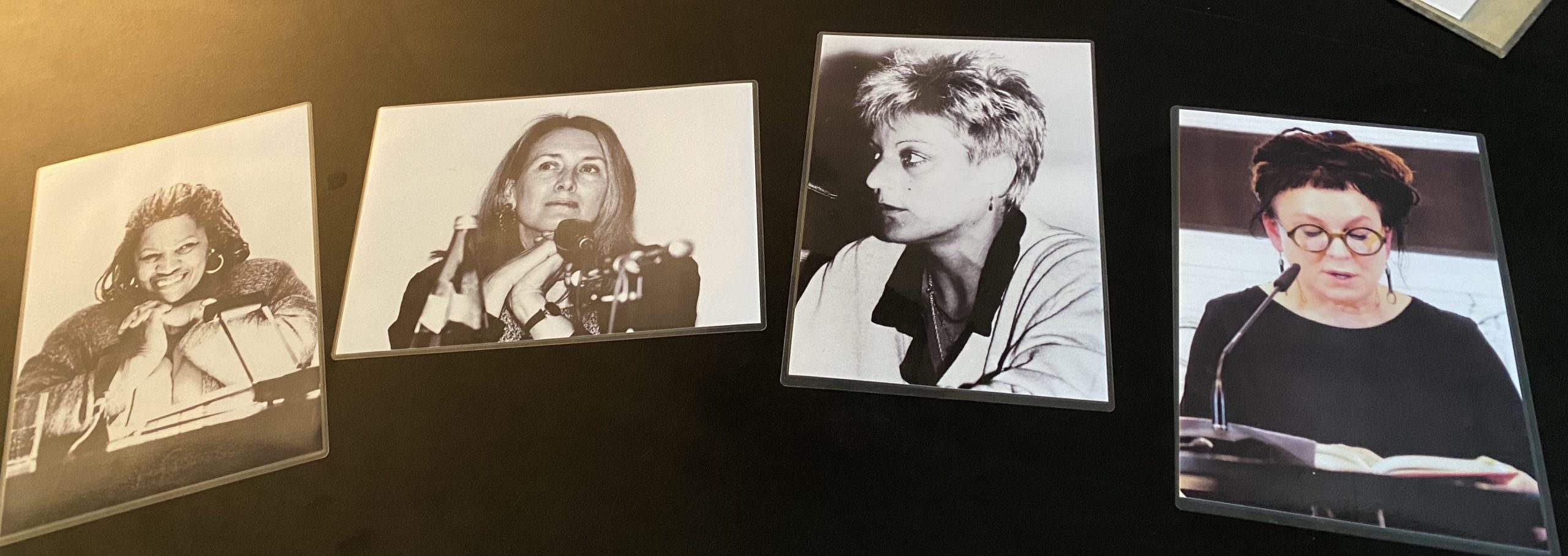

Widmann
Jörg Widmann hat seinen Einstand bei den Berliner Philharmonikern als „Composer in Residence“ gegeben. Die Schwester, Carolin Widmann interpretierte das Violinkonzert Nr. 2 von Jörg Widmann als Solistin. Das war ein ganz besonderer Abend. Die Widmanns haben doch tatsächlich gemeinsam die Einführung in das Programm des Abends mitgestaltet, eine ¾ Stunde vor dem Konzert im großen Saal der Philharmonie. Mit Begeisterung haben die beiden Geschwister von der gemeinsamen Zeit der Entdeckungen rund um die Violine in ihrer Kindheit erzählt. Damit wird die faszinierende kindlich, unschuldige, nahezu naive unbedarfte Herangehensweise an das Instrument verdeutlicht, die so charakteristisch ist für den Anfang des Violinkonzerts. Die Entdeckung eines Klangkörpers (vom einzelnen Instrument bis zum Tutti) geht aber rasch weiter zu einer Demonstration der vielfältigen Gefühls- und Virtuositätsregister der Violine. Paganini lässt grüßen, könnte man meinen.
Kaum klingt eine virtuose Passage an, da hinterfragt der Komponist die eigene Begeisterung. Ist das nicht einfach nur Akrobatik, um dem Publikum zu gefallen? Zweifel stellen sich ein und etwas Distanz zum gefälligen Wohlklang. Reflektierte Virtuosität, der Soziologe würde vielleicht auch reflexive Virtuosität als kompositorisches Element verwenden wollen. Notation von Musik und Klängen hat seit dem wohltemperierten Klavier relativ feste Vorgaben. Daran hat sich Jörg Widmann zu 98 Prozent wohl gehalten. Die anfängliche Erkundung des Klangkörpers Violine lässt sich aber nur anders notieren. Innovativ, mit mehr Raum für Interpretation in der Aufführungspraxis. Das betonte so auch die Schwester, die nun wirklich dem Komponisten sehr eng verbunden ist. Interessant war daher ihr Kommentar, dass diese Anfangsstelle für sie gleichsam die größte Herausforderung darstellt.
Die folgende „Fantasie für Klarinette solo“ von Jörg Widmann passte daher gut zu dieser Erkundungsreise von Instrumenten des Symphonieorchesters. Die Klarinette hat in allen Musikepochen und Stilrichtungen ihren Platz behauptet. All diese Anklänge lassen sich in dem Solo, welches der Komponist selbst dargeboten hat, wiederfinden.
Nach dieser aufregenden Reise durch die Jahrhunderte der Musikgeschichte stand die „Reformationssymphonie“ von Felix Mendelssohn-Bartholdy auf dem Programm. Spannend war die Umsetzung „dieser Art von Teufelsaustreibung“ (Worte von Jörg Widmann) mit dem „2. jüdischen“ Satz und dem „3. protestantischen“ Satz der Symphonie in denen Felix Mendelssohn-Bartholdy seine beiden Wurzeln in den Gesängen und Liturgien in Andeutungen aufnimmt. Mit Klängen und Fängen der ausgehenden Romantik wurden wir in den weiteren Abend entlassen, samt Eindrücken aus der Ausstellung zu der Entstehung (60 Jahre) und der Architektur der Berliner Philharmonie und dem Scharoun Ensemble (40 Jahre) der Gebäude einschließlich der Stabi West. Das Mendelssohn Archiv hat in der benachbarten Stabi West einen kleinen, feinen Ausstellungsraum mitten im großen Lesesaal. So haben wir einen umfassenden Rundblick und Ausblick genießen können, die dem Kulturforum in eindrücklicher, dennoch unaufdringlicher Weise, eine hervorragende Stellung einräumen.
(Image: Jörg Widmann jenseits des Schattens von Furtwängler 2023-9-9)
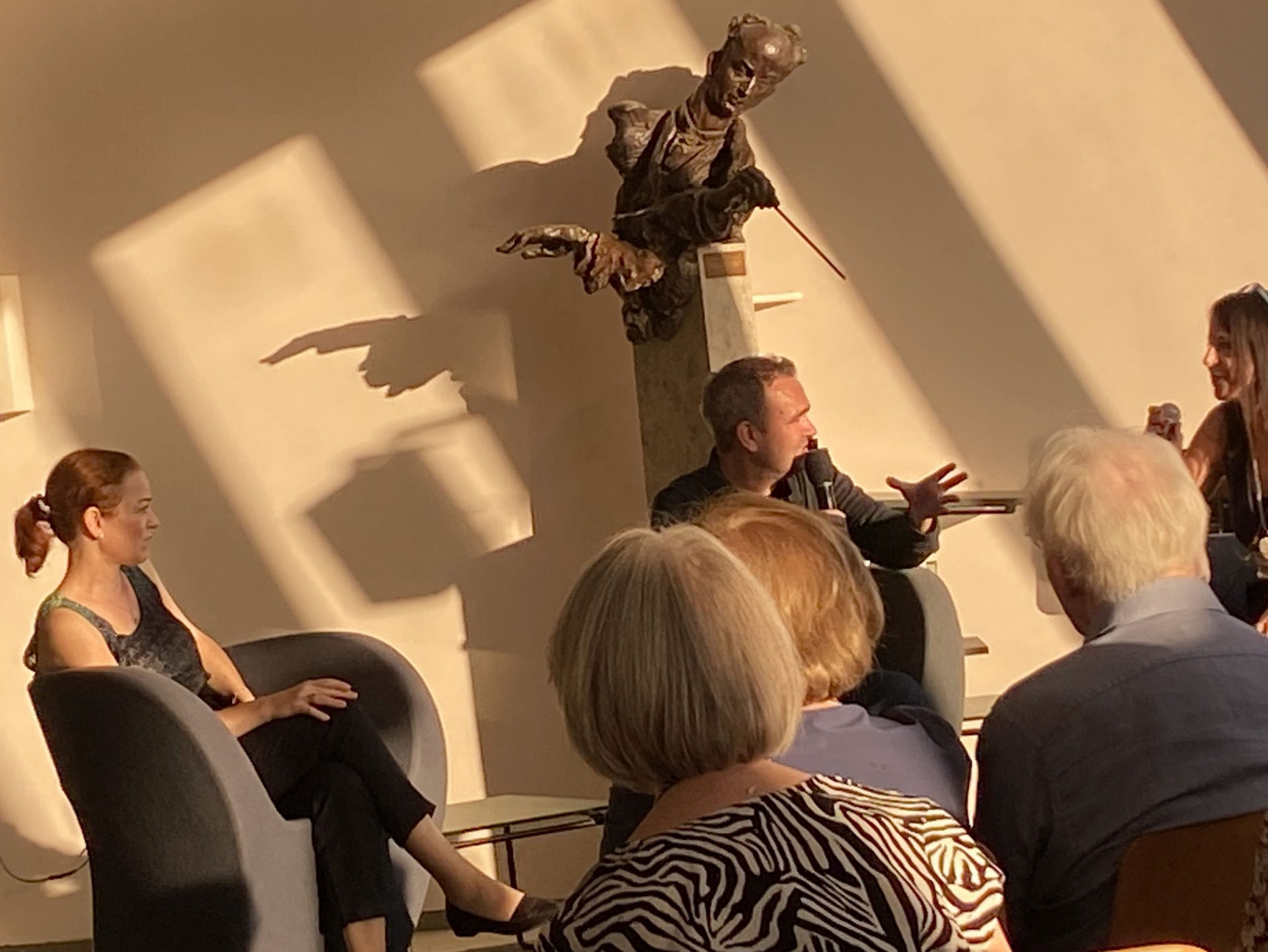
Denkmal
Jedes Jahr gibt es die hervorragende Möglichkeit am Tag des offenen Denkmals, historisch wertvolle Gebäude und Anlagen zu besichtigen. An heißen Tagen, wie in 2023, sind Altbauten oder klimatisierte Räumlichkeiten besonders bevorzugt. Die Philharmonie hat erneut die Möglichkeit geboten ohne langwierige Voranmeldung, spontan vorbeizukommen und an einer Führung teilzunehmen. Das von Hans Scharoun entworfene Gebäude samt seiner akustischen Spitzfindigkeiten bietet spannende Einblicke. Stille, Sound und Noise in einem Gebäude und Konzertsaal will sorgfältig geplant sein. Kompromisse mit verfügbaren finanziellen Mitteln und Planungsverfahren gehören zur baulichen Realisierung, wie eventuell zu den Kompositionen, die dort aufgeführt werden. Heute erscheint uns die gelungene Akustik als historischer Meilenstein. Ebenso die Form des Konzertsaals mit Plätzen hinter dem Orchester, aber auf das Gesicht der Dirigierenden bietet einzigartige Einblicke in die Praxis der Aufführung. Für 10 Minuten war selbst bei der Führung zufällig ein Zuschauen bei der Generalprobe der Berliner Philharmoniker von weitem erlaubt. Komponist und Dirigent Jörg Widmann probte noch Ausschnitte aus der am Abend aufzuführenden Werke. Selbst hoch unter dem Dach der Philharmonie konnten die leisen Ansagen des Dirigenten leicht verstanden werden. Akustische Meisterleistung der Architekten. Wer hätte gedacht, dass Anfang der 60er Jahre eine solche Glanzleistung möglich war, im Berlin, das gerade erst durch die Mauer getrennt werden sollte und dann geteilt überleben musste.
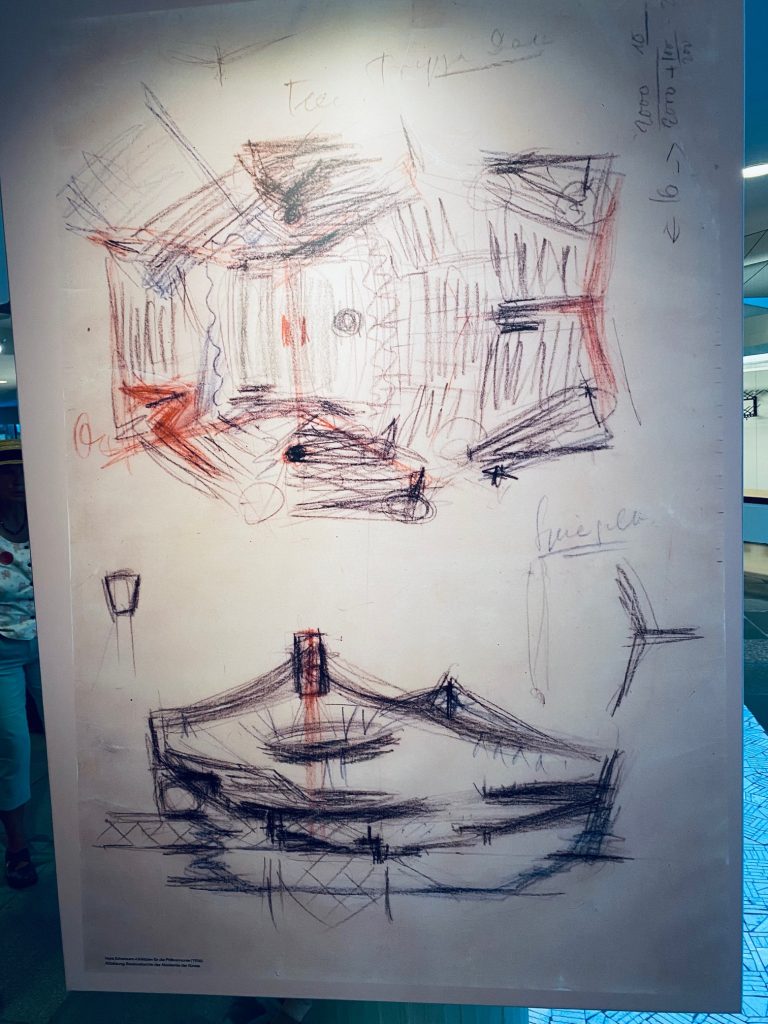
Silence
In the modern world places of silence have become rare. During the industrialisation noise has become a synonym for modernism. Many people even celebrate noisy engines as an image of strength or horse power. In the wake of the 21st century is has become evident that this co-evolution has made us sick and whole cities suffer from the abundant sources of noise.
Can we talk about silence? No, wrong approach, but we can write or realise images dealing with silence. Yes, surely. Spiritual locations often build on the mystic experience that silence might incur. Measuring silence in physics is a lot more complicated. Sound has several forms of measurement. Also, silence is probably experienced by most of us as a relative concept. Compared to a noisy atmosphere we might appreciate less noisy situations as more or less silent already.
Therefore, a reasonable, but evasive definition of silence is the absence of noise. Depending on our auditive capabilities different persons will define silence at different levels. Sound near us blends into sound in the background and vice versa.
Temporality plays an important role. In complete silence we might imagine even to be dead. Otherwise, some distant vibes or vibrations will reach us and potentially stimulate our senses. Silence works as a bridge between two atmospheric impressions. It creates a feeling of expectation for something still unknown. Silence is underrated as our smart phone attempts to disrupt silence as much as possible to draw our attention to messages or reminders. Hence, silence is about to be turned into a new status symbol. Practice of meditation, listening to isolate and subsequently to discard sound, has become an advanced level competence, not only for musicians. Feel free to be silent and see what happens around you. It is easy in locations of supposed spirituality or in most libraries. Almost everywhere else you have a hard time to experience a silent atmosphere.
The composer John Cage made silence the title of one of his quite well known pieces. The willingness to pay for the entry to the silent concert might be surprising although the listening experience is unique to each location and diversity of audience. Composing silence remains a challenge, making noise is easy. (Image: NASA/ESA Hubble Space Telescope, extract of Link) 
Write, write, write
A poster announcing the “internationales literaturfestival berlin 2023” prints in big letters: “Read, read, read, … 14 times”. This is a quote from Werner Herzog when he was asked what makes a good filmmaker. The message from Manjeet Mann to the young audience at Berlin added to this: “write, write, write”. At least this was my impression as a summary of the talk and her short readings from her novel in verse “The crossing”.
The lecture hall of the “Stabi” was packed with students from high-school who felt at ease with the English language presentation and talk. The host Shiva Mesgarian managed to get the crowd of students to ask questions in the huge lecture theatre. 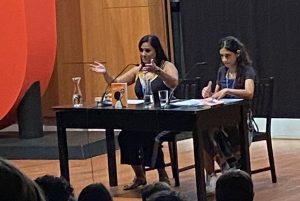 Manjeet was giving a lot of insights into writing, editing, motivation and the difficulty to give a voice to persons from marginalized backgrounds. In her case as a person of colour herself, born and raised in England with additional links to India, she took issue with the topic of refugees. Living in Folkestone (Kent), she is confronted with people crossing the Channel on a daily basis.
Manjeet was giving a lot of insights into writing, editing, motivation and the difficulty to give a voice to persons from marginalized backgrounds. In her case as a person of colour herself, born and raised in England with additional links to India, she took issue with the topic of refugees. Living in Folkestone (Kent), she is confronted with people crossing the Channel on a daily basis.
Her book “The crossing” is actually building bridges between countries and continents. Her entertaining way to talk about her hard work as writer motivates, inspires and encourages young persons to pick up their pencil and/or notebook to start writing. Just don’t stop. Journaling helps. Take your emotions of an issue seriously, then work on it. Give characters a voice who have not received much attention. Go out and interview persons to get authentic input.
It is not about appropriation of a story. It is about meeting and exchanging with marginalised persons. Return your written pieces to those “sensitive readers”, whose story you attempt to develop. All this takes time. Re-writing is an important element as well. “Having written the story for yourself, you then re-write it for the readers”. Edit, clarify, sharpen, blur, attend to detail – all this helps the reader to follow and enjoy. These were the messages to all the students who were grateful for advice as the new season of essay writing in school, university and beyond is about to start. 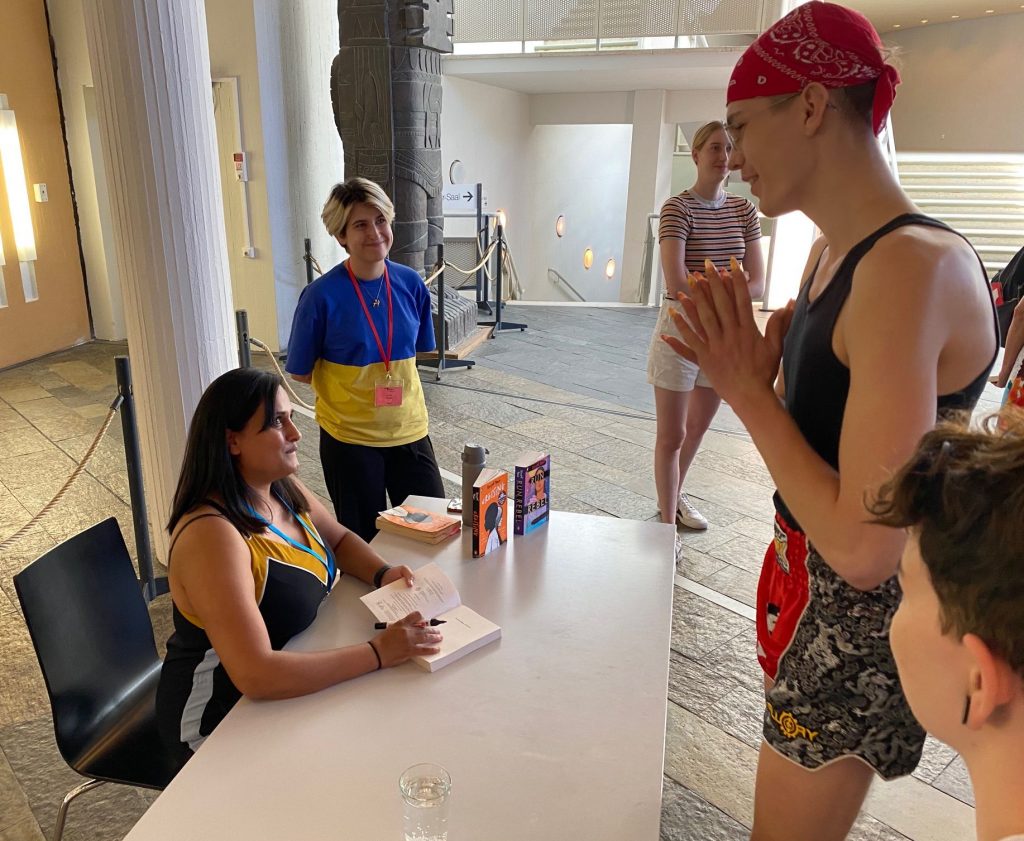
Poetic Coffee Break
The rather stiff and rigid structure of the “Staatsbibliothek” in Berlin does not yet have a reputation to be a place of poetry, translation of poetry and recitals. This is about to change. As a student, researcher or lecturer I would have adored to see my library proposing a poetic coffee break. I would have gone for the necessary break in the afternoon, the coffee and, okay why not, a poetic experience. This time it was different. The organisers, “ilb and Stabi” got together and Ursula Jäcker together with Michael Bucher presented poetry from Shakespeare (Sonnet) in English followed by the German translation by Wolf Biermann.
Translating poetry is a very tricky thing. Just try it yourself and you will be full of admiration for the admirable work of translators of words, sentiments, rhyme and rhythms. The presentation of Biermann’s comments on his own work on translating Shakespeare’s sonnets gave interesting additional information on the short and precise English original and the longer, somehow fat translations into German (Biermann’s words). Thanks for the indication that Biermann deviated from the Shakespearean “iambic pentameter” to add a sixth foot most of the time (to be checked OMG). The choice of numbers 6, 18, 27, 66, 73, 76, 121, 147, 154 from the Shakespeare Sonnets were witty and entertaining for a coffee break. For example, from 27:
“And keep my drooping eyelids open wide,
Looking on darkness which the blind do see:…”
Also, from 76:
“Why write I still all one, ever the same,
And keep invention in a noted weed,
That every word doth almost tell my name,
Showing their birth, and where they did proceed?”
More than 400 years ago, these rhymes were drafted and still today writers and learners, at the Stabi and beyond, can somehow identify with the intricacies of the process of creative writing.
More of this, we need, today and for tomorrow. THX. 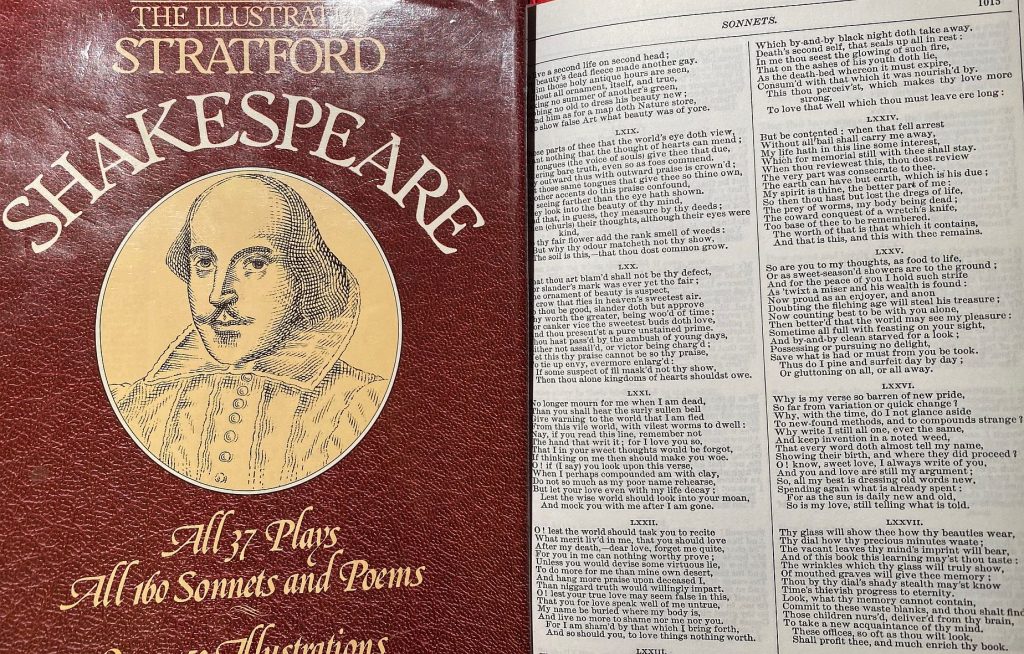
Princess
Berlin is proud to present its princesses after a marvelous lifting. Yes, in the middle of the barbie hype, Berlin exposes two of its princesses of the late 18th century. And you can touch them, if you like or dare to. They don’t bite. I have not seen anybody kissing them either, except for a Spanish football president. All this is happening in the Museum Church Friedrichswerder designed by architect Schinkel an built until 1830s. The grouping of the two sisters was unusual for the time and only the inscription at the bottom introduces the distinction that Louisa on the left is the princess heriting the throne. Frederica on the right is wearing a different foot wear, considered less noble. The privilige to touch the princesses applies only to the smaller copy in front of the image below with “Braille inscription”. The original is further behind. Of course, this one is protected against unwanted contact with the masses or “followers”. At the time “follower” still had a different meaning from today.
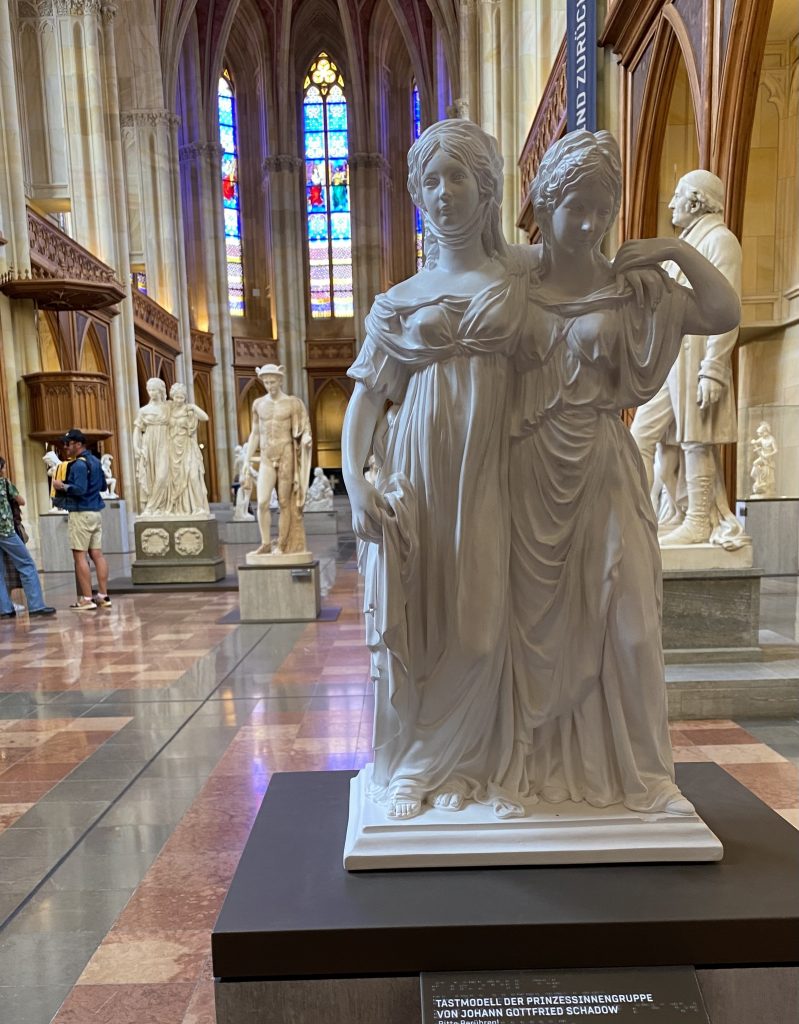
Bogenspannerin
Seit der Antike sind Bogenschützen und Archer ein Thema der Künste. Meistens ist die männliche Repräsentation die dominierende Variante. In Berlin lässt aber auch seit langem eine starke weibliche Realisierung bewundern. Nahe dem Pergamon Museum und der Alten Nationalgalerie steht die Statue der Bogenspannerin. Die Zielrichtung geht Richtung Hedwigsdom, als ob der Kampf zwischen Kunst und Religion ein andauernder wäre. Erfahrene Stadtzeichnerinnen, aber auch Jugendliche fühlen sich dadurch angeregt. Kunstschaffende können einen nachhaltigen Einfluss haben. Innerhalb Berlins ist nicht nur die Vielfalt der Kulturen zu bestaunen, sondern auch der Wettbewerb der Künste um Aufmerksamkeit. Da werden nach Regierungswechseln oft viele Bögen gespannt. Bleibt abzuwarten, wen es alles dieses Mal treffen wird.
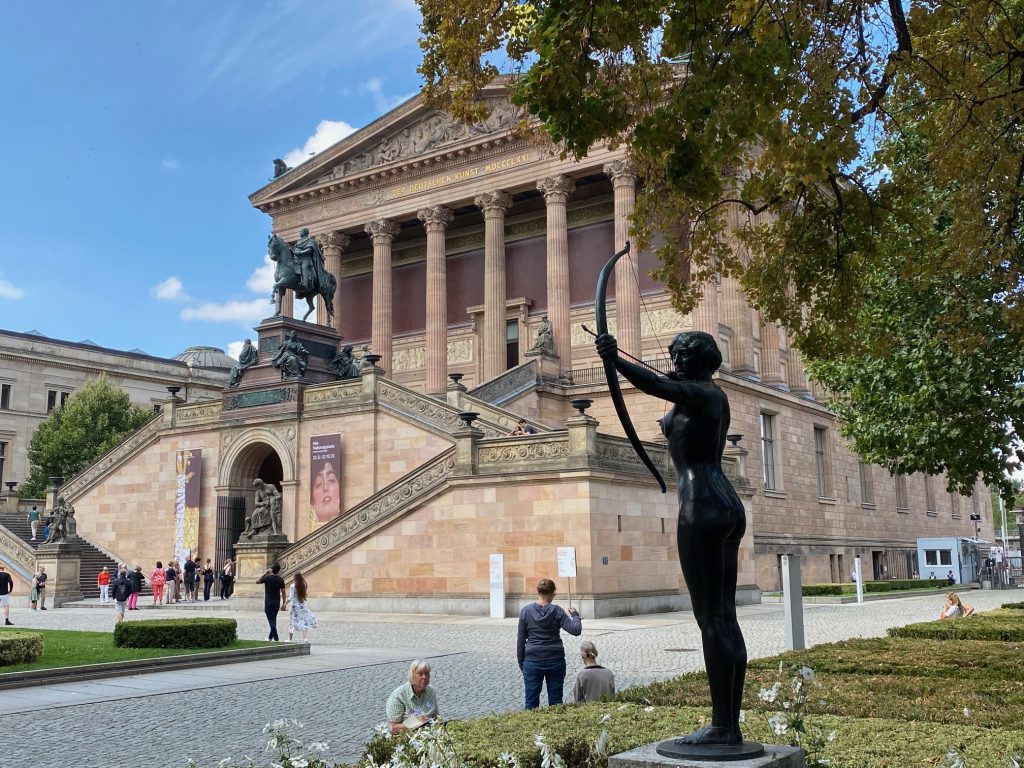
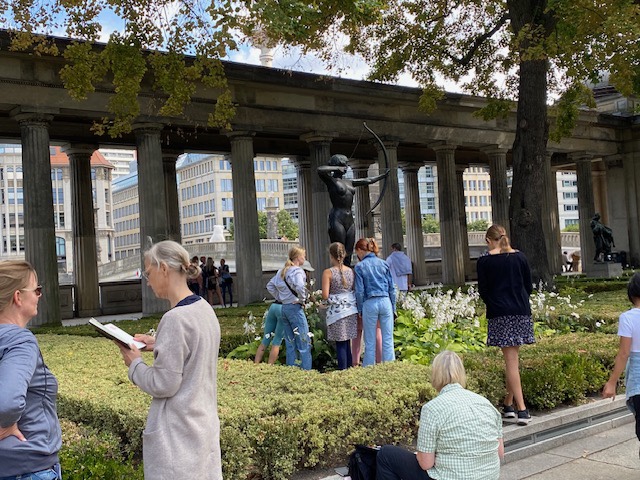
Everyday objects
If you were wondering whether everyday objects can be a piece of art, then the exhibition at the “Neue Nationalgalerie Berlin” is for you. Isa Genzken challenges our traditional view of everyday objects through small transformations of these objects. At first sight you “only” see something utterly familiar to you. A window, a radio, a rose or a wheelchair are immediately recognisable. However, all objects have a little twist to them causing some alienation, questioning or finding new connections. This is the stimulating experience of a visit of the exhibition. The booklet gives an informative overview of choice of sculptures chosen for the exhibition. Walking around in the spacious entry forum allows to appreciate the objects from many angles and in different lighting including twilight. Allow yourself to be challenged. Distancing your perspective beyond the obvious object you recognise broadens our vision of what we see and how we perceive it. The huge pink rose in front of the gallery overshadows even the monumental appearance of the Neue Nationalgalerie. In memoriam “Rosa Luxemburg” and Karl Liebknecht who were murdered not far away, near the “Landwehrkanal” in 1919.
Some visitors might like the skyscraper models she created to remind us that “design catastrophe” with the usual high rising buildings are pervasive around the world. Sculpture as architecture or architecture as sculpture has been her forward looking work from 2008 “Ground Zero – Hospital”.
With the construction work in full swing in the neighbourhood of the gallery with the design of a barn (Scheune) we understand the choice of the artist as a timely reminder that Berlin could be more daring in the architectural design. 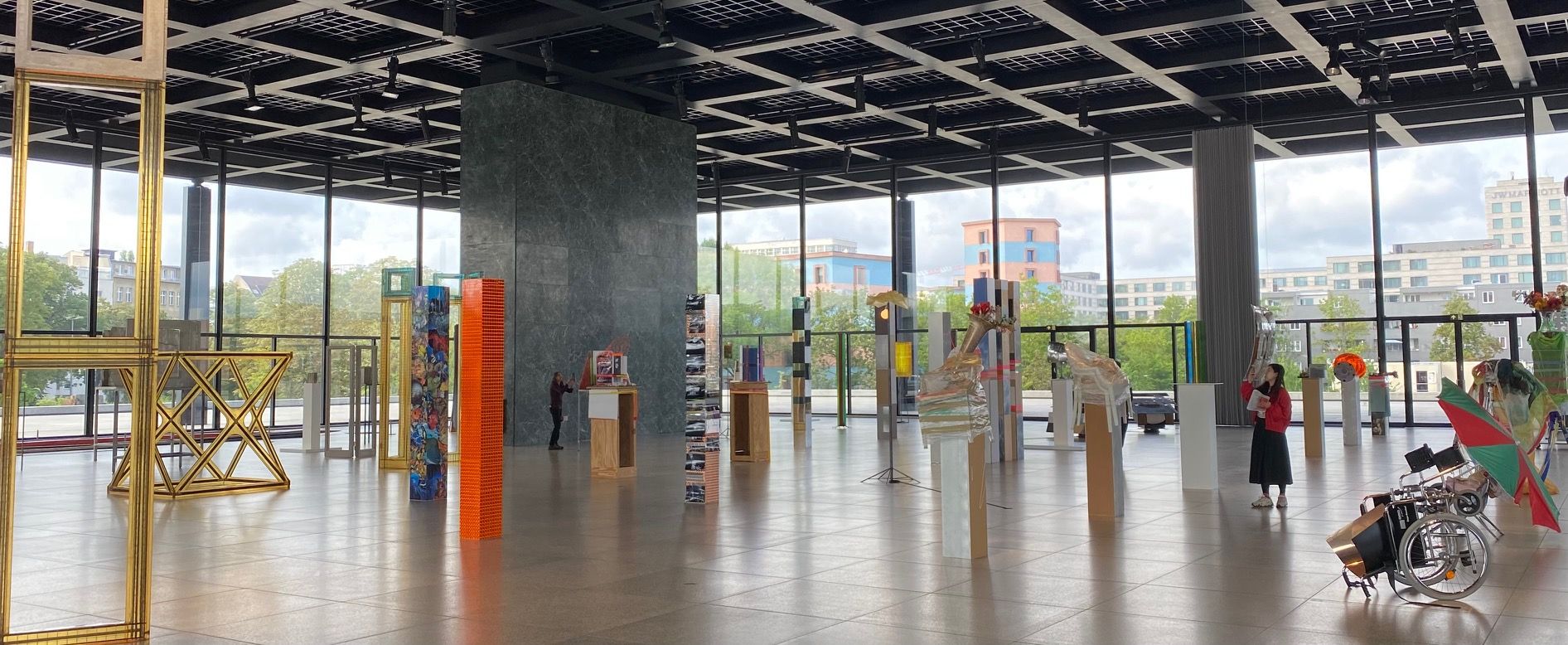
Barbie explore
The film on Barbie after more than 60 years of the first puppets to arrive on the market is a huge money spinning exercise. Hitting more than 1 billion $ is really a huge box office success. More interesting even is the banning of the film in some countries like Algeria. This gives the film an interesting subversive touch to it, which we in the Western countries no longer see as something special. Emancipated women pose a threat to authoritarian regimes.
However, we see in the stereotypes of beauty-driven dolls not that much of an emancipatory chance. To view emancipation independent of the looks of a person is another interesting twist to the role in stereotypes of beauty. It is not only fun to play around with stereotypes, that is mostly, if you are not negatively affected by them (age, gender, ethnicity, extraordinary persons). A nice task for sociology and psychology to explain the working of stereotypes in society and possible remedies. Tolerance is a competence that needs to be learned and updated continuously, from early age onwards.
Therefore, the website created by the US Design Agency Rvnway offers an entertaining way to play around and learn about stereotypes. Perceived, generalized beauty or gender roles can be explored using the tool. Maybe some see themselves differently after such explorations. Everybody is a model. This is the message. www.bairbie.me will let you explore other formats of yourself. After 3-D rendering and printing your children or grandchildren will decide what role they would like you to play in their playfull, or virtual “real” life. I suppose many of us will be up for a big surprise. Go on and imagine in 4D. In the age of selfies all around us, all the time, we believe we are very modern, but the artists of the 19th and 20th century following all great painters before, frequently started their careers with an “autoportrait” or “Selbstbildnis” or series of those as they were aging. 
More Design
How about a subject like Design in school. Rather than the same old boring teaching manuals in art, music, economics or social science, young learners have always been attracted to making things by themselves. The theoretical context is then coming to the subjects and objects more naturally. Economics as market design, design social security for platform workers, sound or furniture design could bring in the creative potential of the learners. Lessons learned through subsequent applications or realizations of prototypes allows the link of theory and practice. A school garden would even be a fantastic cross-discipline learning opportunity.
The most difficult part is probably to find competent coaches to guide the learners exploring and designing. The world is not perfect, so why should learners not be confronted with imperfections in learning set-ups. The most fun part in science is when experiments go wrong, hopefully not too badly though. Catching learners by their curiosity is very likely to get them hooked on more thorny scientific questions as well. Across Europe holidays are coming to an end and millions of pupils go back to their benches and rigid curricula. We should really care more about the next generation.
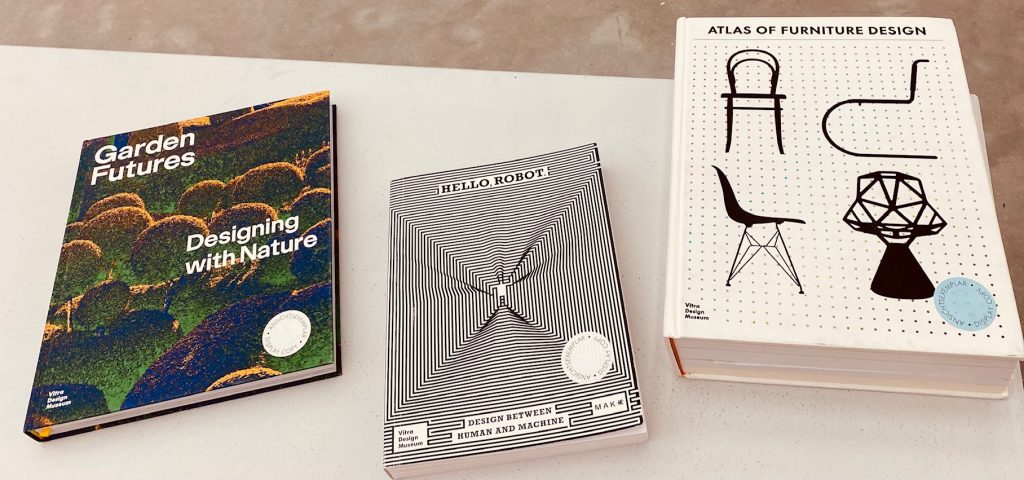
Europa Meer
Europa und das Meer, so lautet der Titel eines Buches und Katalogs zu einer Ausstellung des Deutschen Historischen Museums (DHM) aus dem Jahr 2018. In 2023 im August sind die Zeitungen voll mit Artikeln über Meererwärmung und die schwerwiegenden Folgen für Menschheit und Bio-diversität. Die Geschichte der Beziehung zwischen Europa und dem Meer ist leidvoll und euphorisch zugleich. Alljährlich zur Sommerszeit wird das Mittelmeer von Wellen mit Touristen überspült die „over-tourism“ erleiden müssen. Menschen sind oft eine in Massen, aber nicht in Maßen, auftretende Spezies. Das Meer spielt zusätzlich eine faszinierende, verheißungsvolle Anziehungskraft aus. Europa sieht sich zudem gerne noch als Dreh- und Angelpunkt der Weltgeschichte.
Der Ausstellungskatalog enthält lesenswerte Beiträge von der Antike übers Mittelalter bis in die Neuzeit. Die Thematisierung von Herrschafts- und Handelsräumen , Brückenschlagen und Grenzziehungen, Meer als Ressource bis hin zum Sehnsuchts- und Imaginationsort bieten eine originelle Herangehensweise. Schon 2018 enthielt der Katalog einen Beitrag zum Massengrab Mittelmeer sowie zum Sehnsuchtsort Hafenmetropole Odessa.
Migration in ferne Länder samt der Verheißung eines vermeintlich besseren Lebens sind so alt wie die Menschheit. Die Weite des Meeres suggeriert zusätzlich die Möglichkeit des Neuanfangs und Althergebrachtes, hinter sich zu lassen. Freiwillig oder gezwungen, das ist dabei oft die entscheidende, unterscheidende Frage.
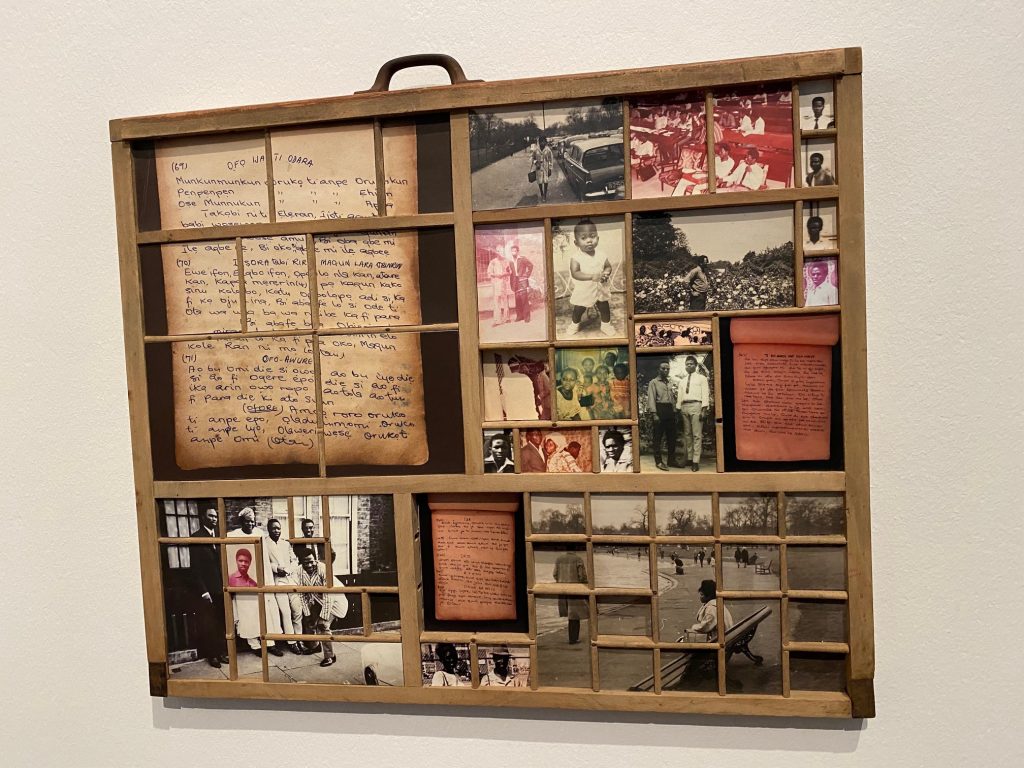
Politicians and Literature
Biographies as well as autobiographies of politicians receive a lot of attention. Even spouses of politicians or artists benefit from this sensational effect (Obama). But beyond these ex-post or after-office effects, it is more interesting to look at what literature or authors have had an impact on the life and, maybe, office of presidents. So-called literary couples or specific relationships between artists or authors can reveal interesting additional information to understand “what made these personalities”.
In “Le Monde” there is a series of articles devoted to such relationships. It is a kind of romantic summer reading satisfying nosy looks into the private lives of politicians and other celebrities of a more intellectual kind. On the 25th of August 2023 it was the turn of the relationship between Francois Mitterrand and Marguerite Duras entitled … “menteurs sublimes, forcément”.
Their long-standing relationship had in common to cover-up some of their failures in the Nazi-occupied France.
Post-war each person had more than just sympathy for the other person’s accomplishments. The interesting feature to accept advice and criticism from the other person is rare for highly exposed persons. Relationships between artists and presidents are somehow tricky for both. As artist you can get instrumentalised by power rather quickly. As politician you run the risk to open-up too much, as they are rarely unobserved. Paparazzi or other agents go a long way to get or make up a good story. “Tell me what you read, and I tell you who you are”. The relationship between literature, politics and politicians will never be easy. It remains good stuff for literature and cinema. 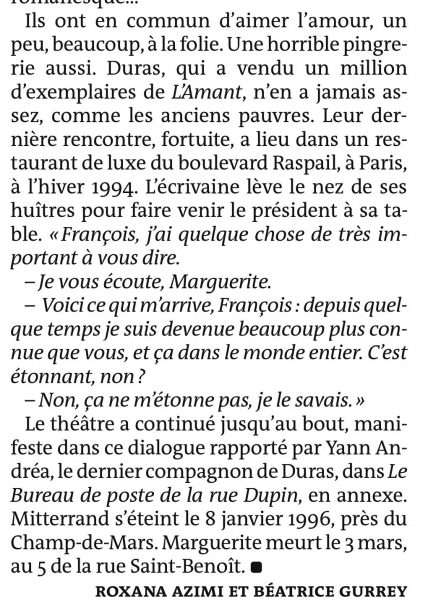
Corbusier ZH
Realizations based on the theory of architecture by Le Corbusier are always worthy of visit. Passing through Zurich (CH) allows to discover another fine example of a villa he designed in the neighborhood of the old town. Within walking distance from the lake Zurich the spacious building allows just like the Paris example for an exhibition of art work within the villa. Horizontally stretched windows and a terrace on the roof make these villas look very modern. Rooftop bars and restaurants just stage a revival in inner cities as cool locations. Le Corbusier anticipated this long ago. Theories can have a long half value time of lasting.
The materials applied in the realizations were obviously less durable. This is the reason why the villa had been closed for renovations for many years. The reopening now shows the splendid views from inside out as well as from the outside. Colors are especially interesting in this example. Nothing is left to or build by chance. The Design language is spelled out in each detail down to door handles. An ongoing exhibition about the deterioration of materials and in some cases even toxic materials helps to understand the necessity to be aware of material science in construction. This makes visits even more informative. The confrontation of vision and sustainability becomes an additional topic also for the theory of architecture.
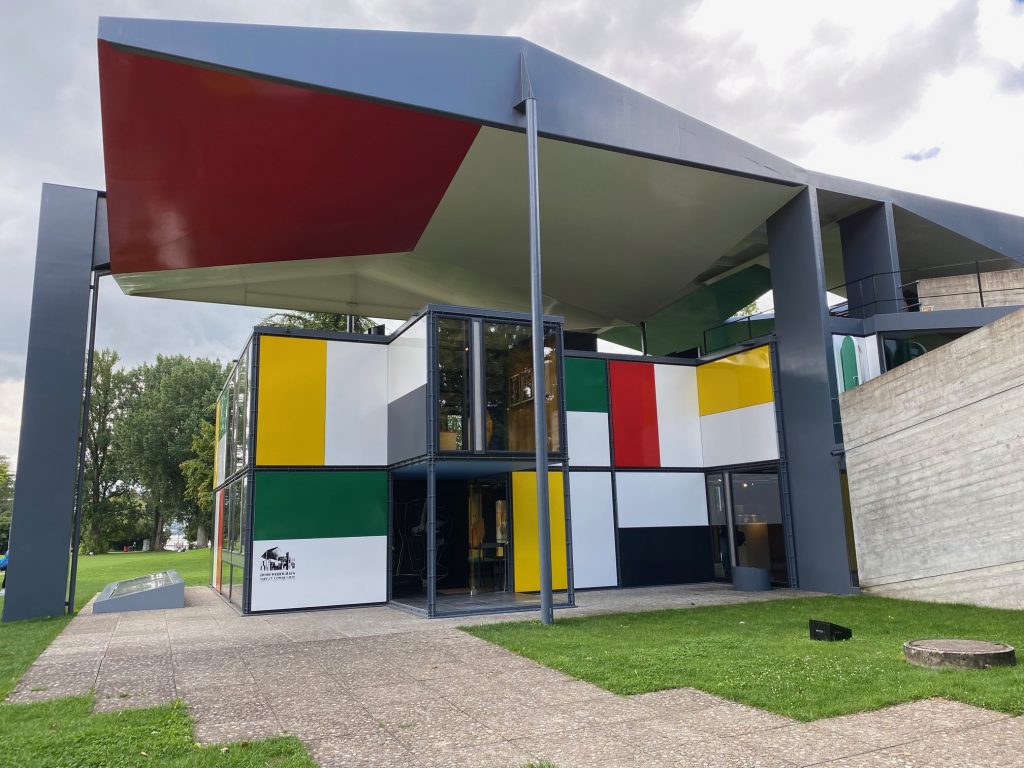
Stilfindung
Kunstschaffende brauchen Jahre, oft auch Jahrzehnte, um ihren eigenen Stil zu finden. Das ist durchaus ein schwieriges Unterfangen. Frühes Ausprobieren verschiedener Kunstrichtungen ist dabei so etwas wie ein Experimentieren mit unterschiedlichen Werkzeugen. Da hilft es enorm, wenn schon einmal ein reichlich bestückter Werkzeugkasten im Elternhaus vorhanden ist. Das war in der Künstlerfamilie der Giacomettis der Fall. Der kleine Alberto hat mit Vater Giovannis Tinten, Federn, Ölfarben und Pinseln früh angefangen, sich auszuprobieren. Eltern, der kleine Bruder, Landschaften, Posen vieler Verwandten und Bekannten sowie jegliche Gegenstände wurden zu Objekten des Skizzierens für den Jugendlichen. Schule war nicht wirklich interessant, selbst die École des beaux arts in Paris erweiterte zwar sein Repertoire an Techniken und Sichtweisen, aber auf dem Weg der Selbstfindung scheint es nur eine Passage gewesen zu sein. Auf dem Weg der Abstraktion hat Paris allerdings die Kreativität stimuliert. Seine Skulpturen von Köpfen der Familie haben sich verallgemeinert, hin zum Universellen. Weit über seine Heimat hinaus sagen die Skulpturen des späteren Albertos uns etwas über Menschheit und Menschheitsgeschichte. Den Weg zu verstehen, den der „L‘homme qui marche“ bis zu seiner Verwirklichung beschritten hat, ist in der Ausstellung im Bündner Kunsthaus nachvollziehbar. Vielleicht mehr ein Lehrstück in Pädagogik und Kunstpädagogik, als in grandiosen Werken der Giacomettis. Welch ein Glück, dass sich Alberto von den Stilrichtungen anderer abgesetzt hat und einfach sein eigenes Ding gemacht hat. Beruf und Berufung können nahe beieinander liegen. Das ist die gute pädagogische Message.
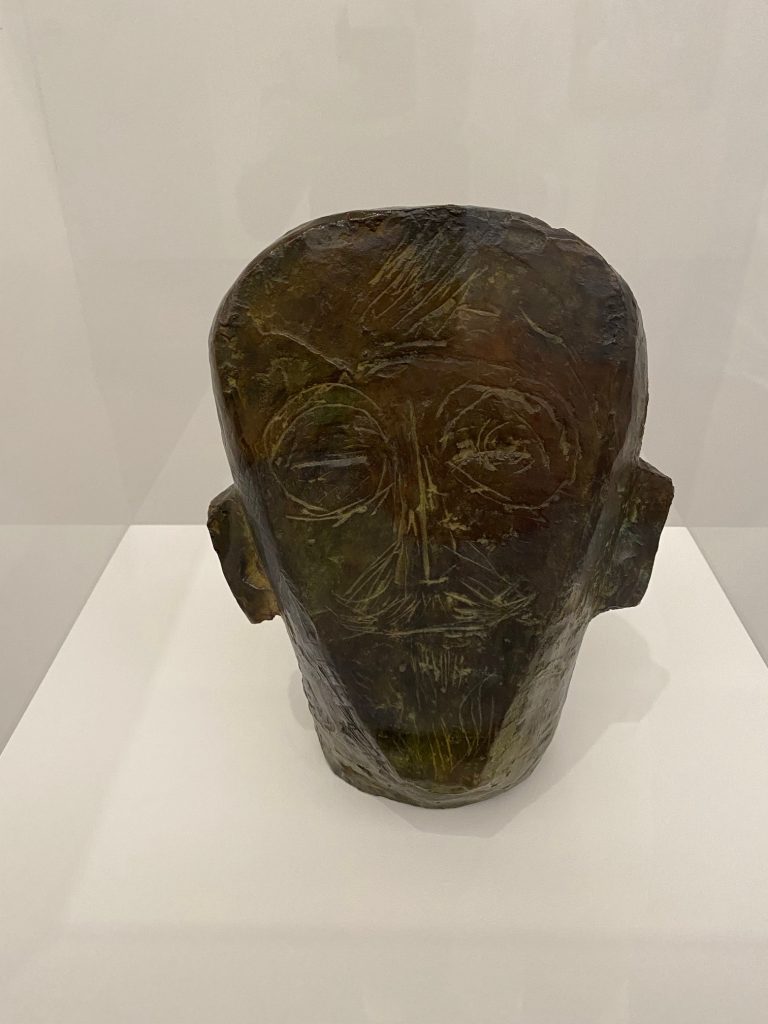
Diplomatin
Der Roman von Lucy Fricke über Diplomatie und Diplomaten ergänzt in recht unterhaltsamer Weise die eher trockene und abstrakte Literatur zur internationalen Politik. Gute Bettlektüre für den politisch interessierten Menschen, der gerade im Urlaub ist. Diplomatie schläft nicht und macht wenig Urlaub. Urlauber dagegen machen den Diplomaten oft ganz schön zu schaffen. Die geduldigen Mittel und Wege der Diplomatie sind nun wirklich nicht jeder Frau oder Manns Sache. Wenn sich Emotionen einmischen wird die diplomatische Herausforderung zu einem nahezu unauflöslichen Konflikt. Diskretion und Verschwiegenheit sind elementar in diesem Beruf. Geduldsproben an der Tagesordnung, ständig und bei allen Dienstgeschäften. Ein nachvollziehbarer Einstieg in diese Berufswelt in Form eines Romans sollte Pflichtlektüre für alle sein, die sich diesem Berufsfeld oder der Aufgabe annehmen wollen. Gut, dass es eine Diplomatin beschreibt. Das gibt eine erfrischende neue Perspektive. Vielleicht auch Anregung über eine feministische Aussenpolitik nachzudenken.
Wenig beleuchtet werden die politischen Umstände, die nur als Staffagen für die Erzählungen herhalten müssen. Taksim Platz samt Wasserwerfer interessiert wohl nur am Rande. Das ist schade, weil es verpasste Gelegenheiten sind, Menschenrechtsverletzungen zumindest kurz anzusprechen. So kratzt die Erzählung nur an der Oberfläche von Personen und dem wirklichen Geschäft der Diplomatie. Aktion in den Vordergrund zustellen ist gut für die Story und Verfilmungen, aber der Kern der Diplomatie muss anders aussehen. Etwas Heimaturlaub konfrontiert die Diplomatin dann erneut mit der weitreichenden Gleichgültigkeit gegenüber der diplomatischen Arbeit. Leben organisieren und Aufräumen bleiben auch im Privatleben der Diplomatin eine Herausforderung der Work-life balance.
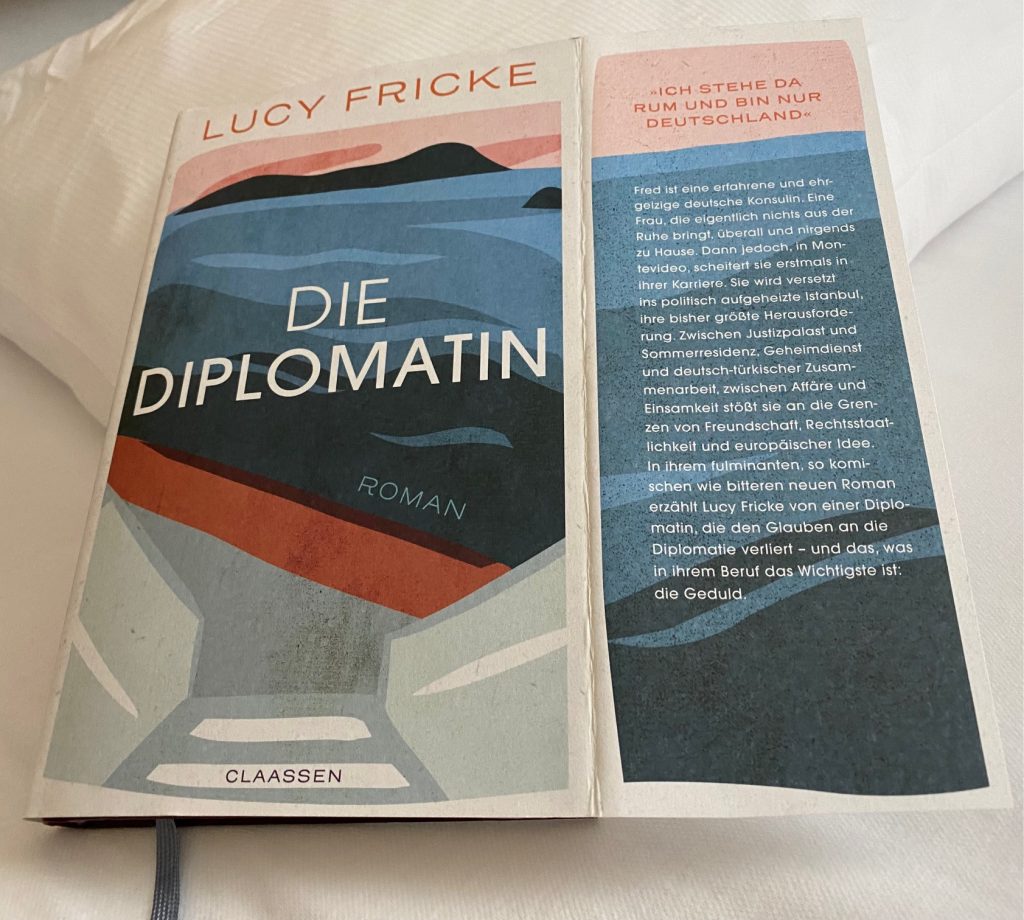
Lotte
Im Forum Würth in Chur lässt sich in 2023 eine erfrischende Ergänzung zu der ebenfalls in Chur zu besuchenden Ausstellung der männlich dominierten Giacometti Familiensammlung erleben. Lotte, die Malerin, hat ein umfangreiches Werk von erlebten Landschaften hinterlassen. Dem Mäzen Würth ist es gelungen, einen bedeutenden Kontrapunkt zu setzen mit seiner Wertschätzung durch den Ankauf einer großen Sammlung. Weg von der bloßen Darstellung von Frauen durch Männer, hin zu Sichtweisen von Frauen. Im Begleittext zur Ausstellung wird treffend von einer Art bildlichem Reisetagebuch gesprochen. Ein Thema das den Kunst und kulturellen Diskurs in Chur seit Jahrzehnten beschäftigt. Aus der Gegenüberstellung zu den Giacometti Werken ergibt sich die Jahrtausende alte Frage des „l’homme qui marche“ und diese war und ist: „quo vadis“. Das ist denn auch der Titel eines im impressionistischen Stil ausgearbeitetes Gemälde von Lotte. Es ist gut in Szene gesetzt, auf violettem Hintergrund. Mäzene können Impulse geben, die dem oft beliebig erscheinenden Kunstmarkt emanzipatorische Anstöße geben. Kostenloser Besuch im Forum für reisende Familien besser als jeder Stopp an der Tankstelle, obwohl wir vor Ort richtig vollgetankt haben, im übertragenen Sinne.
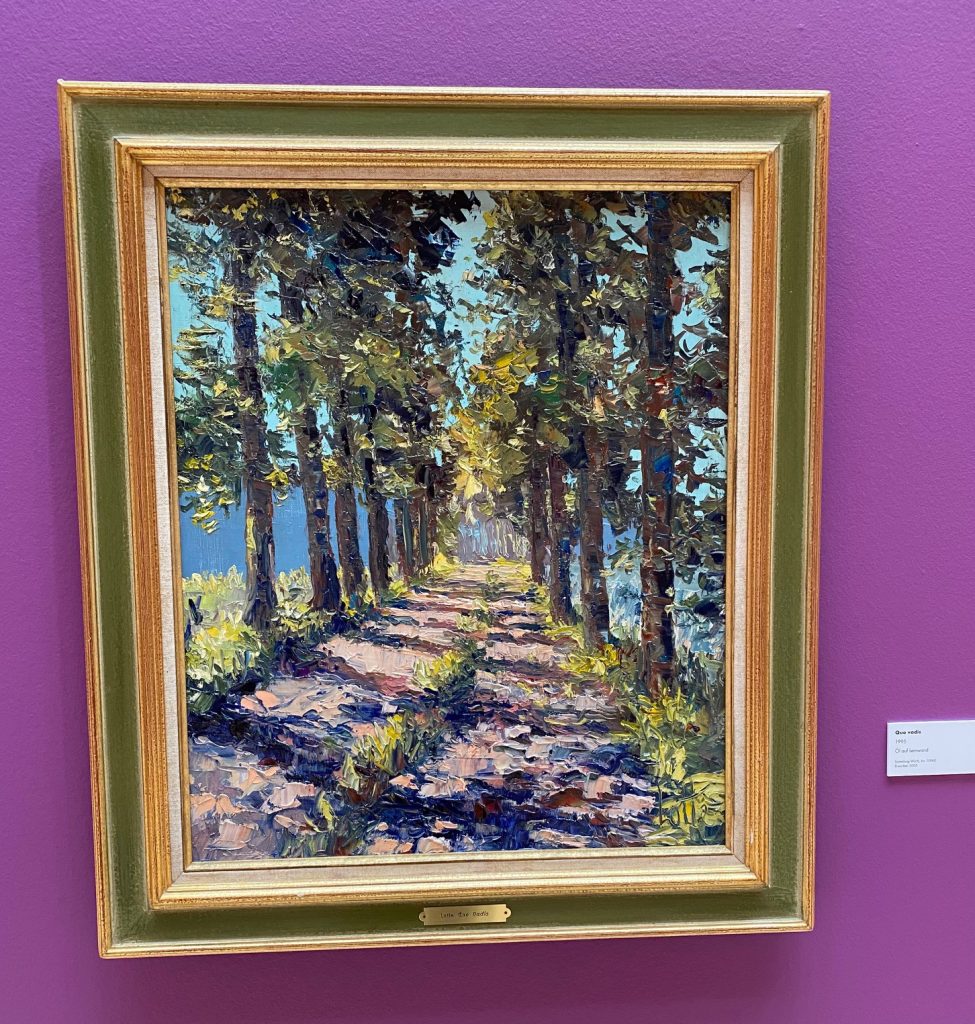
Giacometti
For everyone who enjoys a good walk, with or without dog, Alberto Giacometti is an artist of interest. The world-famous statue “L’homme qui marche” can be admired in several places. Chur (CH) is the artist’s place of death. The most prestigious galleries in Switzerland all have one or several of his art works. In the Bündner Museum in Chur three sculptures of women are perfectly put into correspondence in one exposition room. Eli and Anette from the years 1961 and 1965 talk to Francine with her arms closed in front (title: buste d’une femme). The latter one is from 1962, but was only finished and released as sculpture in 1966, the year of his death or departure. This seems to close a wide circle of creation in the life course of this itinerating artist. Walking the exhibition from sculpture to sculpture is a first step towards meditation walks. Awareness of the stories of the personalities involved widens our horizons. Alberto Giacometti is one of the many artists from the family of the Giacomettis. In the museum in Chur the other family members are well represented, too. Women artists seem to be missing there, probably this needs additional generations.
